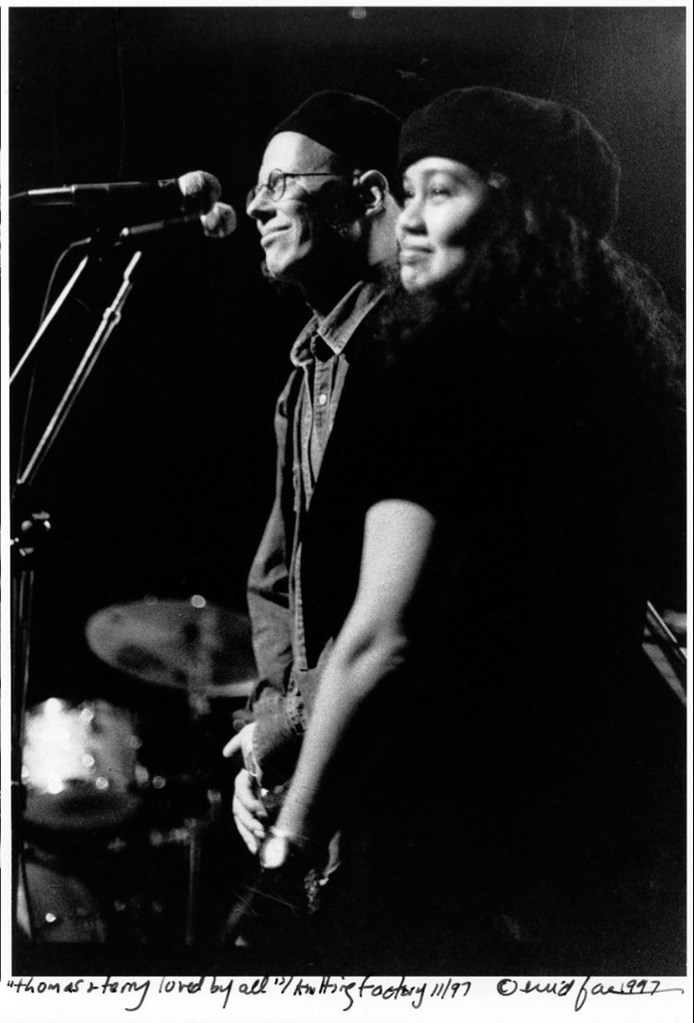Thomas Chapin
The Thomas Chapin era

© Terri Castillo
Friends and colleagues all agree: he was not finished yet. He had just begun and he had to leave too soon. Unfinished business, somebody said. He always played as if it was his last concert ever, someone else said. On Friday the 13th in February 1998, at age 40, Thomas Chapin's struggle with leukemia came to an end. His time was over.
 Newport Jazz Festival 1995 © Elisabeth Brown (Photo permission by Akasha, Inc.)
Newport Jazz Festival 1995 © Elisabeth Brown (Photo permission by Akasha, Inc.)
WHEN THE SAINTS GO MARCHING IN
The era of the American saxophonist, flautist, composer and arranger Thomas Chapin (° March 9, 1957) was set in the late eighties and nineties. The years in which he flourished as a musician, the years his creativity grows into a crackling fire. In his two decades of performing, Chapin is a force, a player with "monstrous chops," whose sound is individual and incomparable. He has an uncanny gift of melding all forms of jazz into a single body of music and his pathway of moving sound is so multi-directional, yet singular, so original, yet steeped in tradition, that the jazz community struggles to categorize him. As one of the few artists of his generation to exist in both the New York City's downtown experimentalist scene and in the uptown world of traditional jazz, Chapin is tireless and passionate in his pursuit of creating an edgy, engaging, cutting-edge sound that pushes jazz forward, while being fearless in showing his mainstream influences. In June 2016, Aidan Levy of the JazzTimes Magazine writes that Chapin is "considered by some to have fundamentally expanded the boundaries of the jazz discourse."
Of course his musical career started years earlier. He's born in a small town, Manchester, Connecticut, U.S.A., in 1957, and as a baby he's banging on the pots and pans (sprawled everywhere) in the kitchen much to his mother's dismay. As an adolescent he takes piano lessons as many kids do and learns the flute. In 1972 he attends a private high school in Andover, Massachusetts, and there a music teacher hears something in his playing and thrusts a saxophone in his hands. That was it! Chapin puts all his focus on the instrument and never looks back. Music will be his calling and life and 'first love.' There, too, he becomes part of an improvisational quartet, Zasis, for eight years. This energetic and free collective will have a lasting influence upon his future musical style and direction. Chapin goes on to study with Kenny Baron and Jackie McLean at The Hartt School of Music at the University of Hartford, Connecticut, 1978, and later with Paul Jeffrey and Ted Dunbar at Rutgers University in New Jersey, 1980, where he gets his BA in music. Barely graduated, Thomas Chapin joins the Lionel Hampton Big Band in 1981. Also in the Lionel Hampton Big Band then were tenor saxophonists Ricky Ford and Arnett Cobb, alto saxophonist Paul Jeffrey and trumpeter Barry Ries. Chapin stays six years as musical director and soloist on alto saxophone and flute. The band tours the world and plays on all the global festival stages. In his book “Jazz The Modern Resurgence” Stuart Nicholson remembers that in that time Hampton, to everyone's surprise, and sometimes horror, chooses ‘In The Mood’ and ‘When The Saints Go Marching In’ as an encore. No wonder that Ned Rothenberg, friend and colleague of Thomas Chapin, typifies the period Chapin works with Hampton as: “He seriously paid his dues.”
Also in 1981, he records under his own name his first-ever album, an LP, "The Bell of the Heart" with Mario Pavone's Alacra label. All tunes are original, except "Body and Soul". Pavone and Chapin had just met and were just starting out their music association. The musicians playing on "Bell of the Heart" are George Alford/Peter McEachern/Phil Buettner/Nick Makros/Lucian Williams/Mario Pavone/Emmett Spencer/Matt Emerzian.
A milestone career Trio performance at Newport Jazz Fest, 1995
After the years with Hampton, Thomas joins the band of drummer Chico Hamilton for two years and in the meantime he also plays in different contexts. A Latin classical chamber ensemble, several flamenco groups, a freefunk-free-jazz-rock band Machine Gun, the straight ahead Connecticut-based jazz band Motation, the NY-based Peruvian jazz singer Corina Bartra, and his Brazilian-Afro Cuban ensemble Spirits Rebellious and album by the same name, (Alacra, 1989), greatly influenced by his hero, Brazilian composer-musician Hermeto Pascoal.
In April 1984 he records a second album under his own name of mostly original tunes, except Fats Waller's Jitterbug Waltz, and is well received when it is finally released in 1990. The CD is "Radius” (on guitarist-friend Bob Musso's MUWorks Records label; Musso is also the album's engineer), with pianist Ronnie Mathews, bassist Ray Drummond, drummer John Betsch, Ara Dinkjian, oud and Sam Turner, congas. Still today a highly-acclaimed work, this engaging record shows how much Chapin was affected by legends like Jackie McLean, Eric Dolphy and Roland Kirk.
Quartet CD release in 1990 (MU Records)
LIVE AT THE KNITTING FACTORY
On the eve of the nineties Thomas starts his trio that develops into his working band par excellence. The trio becomes his laboratory where he examines and tests his possibilities, where he experiments with new formulas, where his own boundaries are challenged. Summer 1989 the Thomas Chapin Trio debuts at The Gas Station in New York's East Village. Bassist is Mario Pavone, who has already formed a close bond with Chapin because of various previous projects they have worked on together, on drums is Pheeroan AkLaff. The trio performs at this small festival organized by Bruce Lee Gallanter, founder of Downtown Music Gallery, a prominent new-music record store in New York City. A half year year later, in December 1989, Gallanter gives them the opportunity for their first concert at Michael Dorf's iconic downtown club, the Knitting Factory, that just exists two years, and became, just as CBGB’s and The Kitchen, the new temple for the New York avant-garde and alternative music. A recording from that concert can be heard on the compilation “Live At The Knitting Factory Volume 3”, and is the start of a close relationship between Thomas Chapin and the Knitting Factory Records label which lasts until Chapin's death in 1998. Chapin’s the first artist with an album of his own on the label that was founded in the beginning of the nineties. He’s also the one with the most albums under his own name for the label.
'Spirits Rebellious' release of original Brazilian music, 1989 (Alacra)
In the meantime it’s now Steve Johns on drums. He stays two years with the trio and plays on two albums with Chapin and Pavone: “Third Force” in 1991 and “Anima” in 1992. The trio’s proper sound, their own language based on compositions and arrangements by Thomas Chapin, slowly matures and seems to come in full bloom, with the arrival of drummer Michael Sarin. He already appears as second drummer on “Anima”, but in 1992 he replaces Johns and gives birth to the definitive version of the Thomas Chapin Trio. For the next six years, this triumvirate plays as a jazz beast with three heads: Chapin, Pavone and Sarin are in perfect match, improvisation and composition are one whole, jazz tradition and free experiments fit nicely together. They sound, in critic Kevin Whitehead’s words, as “hotly, vamping post-free jazz”.
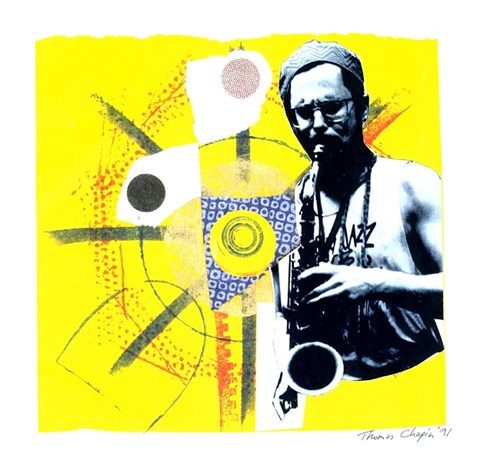
Collage by Thomas Chapin, 1991 (Art by permission of Akasha, Inc.)
In December 1992 the Chapin trio records a CD with six horns. It is the first time Thomas experiments with a larger ensemble of brass players and this gives the trio compositions a new dimension. It results in “Insomnia”, considered a brilliant and outstanding album with Al Bryant, trumpet, Frank London, trumpet, Curtis Folkes, trombone, Peter McEachern, trombone, Marcus Rojas, tuba and Ray Stewart, tuba. The music goes from typical New York avant-garde from the nineties to more mainstream jazz in which he can use the experiences from his Hampton period. And in addition he shows his ability as an arranger and composer from open themes with a lot of improvisation space. Four years later he extends the trio with a string section on the CD “Haywire” which receives similar accolades and praise for another expanded trio assemblage with Mark Feldman, violin, Boris Rayskin, cello and Kiyoto Fujiwara, bass. It includes a beautiful , haunting rendition of 'Diva,' a composition by Italian jazz trumpeter Enrico Rava.

SJU Jazz Festival, April 9th, 1994 © Marinus Lavèn
YOU DON’T KNOW ME
1992-1996 is probably his most productive period and also his most creative. In these four years he releases another trio CD “Menagerie Dreams” (1994), with saxophonist John Zorn and poet Vernon Frazer as special guests. Yet to come are his last Trio albums on the Knitting Factory Records label which include what Chapin considers his best-ever work, "Sky Piece" (1996).
Also in these formidable years, the trio gives milestone world-stage career performances: in 1993 at the Madarao Jazz Festival, Japan, which showcases his trio in one of the first overseas big-stage appearances, and also on that date, Thomas plays with legend Betty Carter. While crossing the Pacific Ocean to return to the U.S., the trio stops in Hawaii and gives a stellar performance at the prestigious Honolulu Academy of Arts.
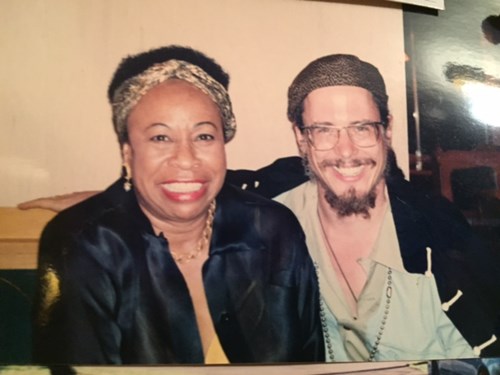
Thomas and Betty Carter at Newport Jazz Fest in Madarao (Japan).
Photo permission by Akasha, Inc.
Says Mario Pavone, "He was terrified of what key she might sing 'Speak Low' in ( singers always sing in unusual keys ). But this [photo] is after .. and he had nailed it !!!!"
In 1995 the trio gives what is considered by many to be a breakthrough and unforgettable U.S. performance at the renowned Newport Jazz Festival in Rhode Island. You can still feel the impact the artist made on the lives of all that came in contact with him. Laurence Donohue-Greene, Managing Editor of The New York City Jazz Record, recalls, “Thomas performing at Newport in 1995… That was a life highlight in music for me. Over 20 years ago and I vividly remember that set to this very day as still being one of the greatest Newport Jazz Festival sets I’ve ever seen.”
In 1996 at the prestigious Umbria (Summer) Jazz Festival, in Perugia, Italy, the trio plays to standing ovations in an unprecedented 10-night marathon at Club Il Pozzo. Ironically, because his illness is on the near horizon, an 'epiphany' Thomas has during this significant summer engagement in Umbria won't be tested: " ... The standing ovations made Chapin realize that his 'forward looking' music had reached the point where it was appealing to a more extensive and varied audience than he had imagined," New York Times critic Mike Zwerin writes. To add to the pile-up of heartbreaking losses to come as the forthcoming adversity starts to overtake the impressive successes for Chapin, an invitation to return to this important Fest must be forsaken. Carlo Pagnotta, director of Umbria Jazz Fest, asks Chapin to bring back three of his groups for the Winter, 1997 Fest: his trio, a quartet or quintet, and the trio plus strings or brass ensemble. Chapin's tragic diagnosis of illness at the end of January, 1997 sadly prevents him from fulfilling this meritorious return engagement.
(Editor's notice: For Zwerin's entire article, scroll down to after 'The Press' quotes, to read "Thomas Chapin's Last Europe Interview.")
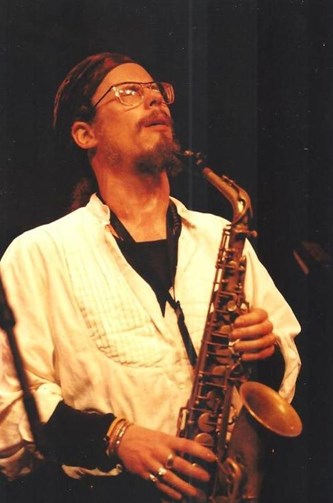

SJU Jazz Festival, April 9th, 1994 © Marinus Lavèn
Also in these years are some memorable NYC downtown concerts, Chapin appears as guest with a hiphop-freejazz project (Species Compability by Ken Valitsky), and also plays improvisational music with Under Cover Collection Band with a.o. Tom Cora. He does some formidable performances with legendary avant drummer William Hooker in 1992, and it results in the posthumous CD release "Crossing Points" on the Lithuanian NoBusness label (2011). Besides these avant-garde projects the versatile saxophonist maintains his strong mainstream side: Chapin as hardbopper with a sound referring strongly to Phil Woods.
For Arabesque Records, a jazz and classical label, he makes two albums: “I’ve Got Your Number” (1993) and “You Don’t Know Me” (1994). Here Chapin leaves the trusted trio nest and works in a quartet and quintet setting with people as Tom Harrell, Peter Madsen, Reggie Nicholson, and old friends as Ray Drummond, Ronnie Mathews and Steve Johns. These two albums, much praised, absolutely place Chapin as a jazz master who firmly belongs equally in the traditionalist camp as the avant garde. As critic Chris May in allaboutjazz wrote, "[He] was his own man, but his music resonated loudly with the work of reed giants from an earlier age."
The following year, 1995, he starts a session for Knitting Factory with Anthony Braxton on piano. Together with Dave Douglas, Mario Pavone and Pheeroan AkLaff they play “Seven Standards”: wonderful solo moments but not enough interaction. Much more interesting is “The Fuchsia” (1997 release on Koch) from a couple of months later: the only recording of the Peggy Stern/Thomas Chapin Quartet, one of his lesser known mainstream projects with Drew Gress on bass and Bobby Previte on drums. There’s a great understanding between Chapin and the pianist and composer: Stern delivers most of the compositions and Chapin feels very comfortable with them. It’s an album with plenty of pleasant surprises, funky rhythms, nice melodies and strong interplay. In addition it’s one of his few recordings with a pianist; nevertheless totally different than the improvisation duo with the late celebrated NY free pianist Borah Bergmann (“Inversions”, 1992) or “Watch Out” in quartet with pianist Misako Kano, Kyoto Fujiwara and Matt Wilson, recorded in 1996, but posthumously released in June 1998. Also in 1996 with Netherlands musicians, Vandoorn (Ineke van Doorn, Marc van Vugt) + Thomas Chapin: President for Life (VIA, PIAS; Belgium) CD was released..
Thomas Chapin Trio @ North Sea Jazz Festival, The Hague, Netherlands, 1995
After eight years of great and still-rising success with the trio, Chapin takes a well-deserved break in early 1997 to travel to, for him, the beloved continent, Africa, a place of lifelong musical resonance and influence. Over the years, he's been several times to visit and explore and on one occasion, he plays in a Cape Town club at the invitation of Connecticut bassist-friend Hotep Galeta, who was living in South Africa at the time. But on this new trip in early 1997, he visits eastern and coastal area, Uganda, Tanzania and Zanzibar. In Zanzibar he meets local musicians and helps a French musicologist record them. It is here, sadly, that Chapin's unbelievable downturn begins. He gets sick with fever, is weakened and must return to New York. Once home, he is immediately diagnosed with leukemia. It is February, 1997. The treatments last for a full year. There are some hopeful moments, but tragically he is not to recover. Mario Pavone, critics and others lament this fate, describing the up-to-that-point, undeniable upward movement of Thomas and the music: "The plane was just gaining altitude."
In the Fall of 1997, Chapin is too weakened by his leukemia to continue his work. He stops performing and there are no more recordings after a very busy previous year of sessions with musician-friends: Ineke Vandoorn, Misako Kano, Mario Pavone, Michael Blake, Barbara Dennerlein and Pablo Aslan. Together with Aslan, a bassist, originally from Argentina, and pianist Ethan Iverson they had formed Avantango as a septet in 1994. They play “spontaneous tango” as it is called by Aslan in the liner notes from the now-Trio group (with Aslan, Chapin and Iverson) CD “Y en el 2000 también” (1996): tango trying to incorporate jazz and free improvisation. Thomas' original tune, "Telling Comment" is included in the recording.
Throughout his musical years, Chapin has been using a cross pollination between jazz and non-Western music, world and indigenous music in his compositions: Armenian-American oud master-friend Ara Dinkjian plays on Radius (1984) for instance, or the suite “Safari Notebook” (from “You Don’t Know Me”, 1994) in which Chapin incorporates impressions from his journeys through Africa and Namibia. And on I've Got Your Number, 1993, he uses the master Afro-Caribbean percussionist Louis Bauzo on congas. Chapin studied with Bauzo in 1991 through a grant from the National Endowment for the Arts, Amercan's prestigious public funding body. "For all the diversity of his musical experiences," writes bassist Vernon Frazer in the liner notes, "Chapin is no musical dilettante flitting from one genre to another, his commitment to music in all its varieties is total. 'I do it for the joy of playing, of becoming the music that I'm playing.' says Chapin. 'It's not like putting on clothes. It comes from within. I'm exploring different facets of my personality.'" Frazer continues, "Chapin's voice remains constant, spicing each musical dish with his distinctive, energetic sound."
With AVANTANGO
AEOLUS
The last session with the Thomas Chapin Trio was recorded in July 1996 in the studio by his trusted engineer Robert Musso. It was released on the Knitting Factory label as “Sky Piece”, considered by many still today as one of Chapin's outstanding works of his career. His mainstream and avant-garde jazz are forming into a harmonious whole. Free trio improvisations alternate with nicely built and engaging compositions with subtle hints of his interest in African music; the only track he hasn’t composed himself is Monk’s “Ask Me Now”. Carefully dosed exotic sounds give color to the music: Thomas not only plays alto sax and sopranino, but also flute, bass flute and wooden flute and he uses bells, toy flutes and an alarm clock. Called during these trio years, 'the flute master of his generation,' Chapin's dexterous and consummate flute playing in Sky Piece testify to his undeniable command and dominion over the instrument. The common thread through the album seems time, the merciless clicking of the clock, the realization that his time has come. It’s only just before his death that he could make the recording ready for release.
But there was more unreleased trio music on the shelf: "Night Bird Song" was recorded at Kampo Cultural Center, NYC, from August and September 1992, for instance. But we had to wait until 1999 to hear this music on the Knitting Factory label. It was Thomas’s wish that this CD be released after “Sky Piece” (1996). Both CD’s have three compositions in common. The arrangements are not very different, but nevertheless there is a clear difference. On “Sky Piece” there’s balanced beauty--the trio is at its peak; while “Night Bird Song” is intense and full of wild enthusiasm. The pieces sound rougher and less polished: this is the young trio in a promising growth phase. One of the pieces that was never released before is “Aeolus”, a touching duet with Mario Pavone: brilliant interplay from two musicians that understood each other like no one else. No wonder Pavone records the same title with his own Nu Trio for “Remembering Thomas” (Knitting Factory, 1999), his homage to his great friend and colleague.
“Aeolus”, Thomas’s ode to the god of the wind, is also the last music he blows through his instrument. His last public performance is in Manchester, Connecticut – his birthplace - on February 1st, 1998. Two days later he’s back in the hospital and on February 13th Thomas, at age 40, lost the fight against his leukemia. And that’s the end of Thomas’s era.
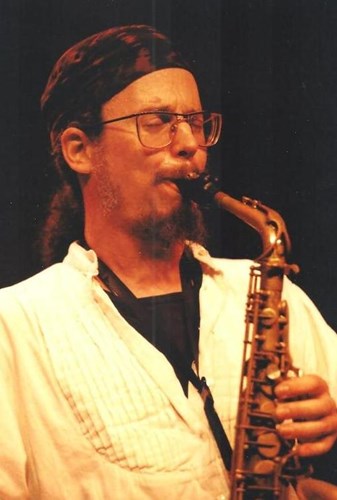
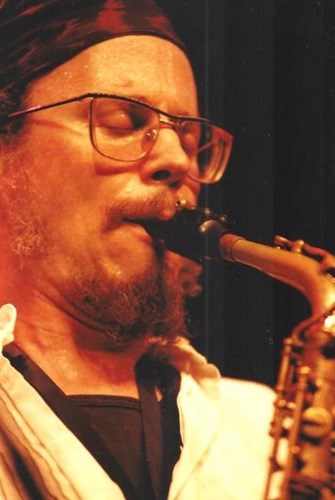
SJU Jazz Festival, April 9th, 1994 © Marinus Lavèn
Based on the original text (in Flemish) by Jeroen Revalk (published in the paper version of Jazz'halo 1999, #4) and updated (in English) by Teresita Castillo Chapin (July/August 2016).
Translation to English: Jos Demol (with special thanks to Teresita Castillo Chapin for the corrections) (June 2016)
Visit http://www.thomaschapin.com/ and http://www.thomaschapinfilm.com
Electrifying Night For Thomas Chapin
February 03, 1998 | By OWEN McNALLY; Courant (Connecticut) Jazz Critic
Not even the word "electrifying'' has quite enough emotional voltage to describe the jolting impact of jazz musician Thomas Chapin's surprise performance Sunday night at a benefit held to defray the skyrocketing medical costs of his battle with leukemia. Halfway through the standing- room-only concert at Manchester's Cheney Hall, the buzz was that Chapin might be not be well enough to appear at the fund-raiser, which featured dozens of musicians donating their efforts.
But midway through the second half, bassist Mario Pavone, a longtime friend and collaborator, announced that Chapin was not only in the house but would perform an original piece on flute. Chapin, who was sitting in the wings with his wife, Terri, walked out on stage, looking gaunt and ill but spiritually resilient, smiling widely while enveloped in warm, loving applause. Warning that he might become overwhelmed with emotion, the 40-year-old Manchester native expressed thanks for the benefit, which turned into a giant Chapin love fest.
"I've been blessed to know so many of you. . . . So much adds to the healing,'' Chapin told the packed house of 350 friends, fans and family members.
Deeply moved, he played an emotion-drenched flute solo. For a few bright, magical moments, it seemed as though the clock had been turned back before his harrowing ordeal began with the debilitating disease and series of chemotherapy sessions, transfusions and hospitalizations. At the height of the instrumentalist/composer's growing national prominence one year ago, he was diagnosed with acute myeloid leukemia, a disease in which malignant cancer cells are found in the blood and bone marrow.
Chapin's impassioned, soaring solo filled the elegant, old Victorian- era theater with a powerful, real-life drama. Spellbound, the audience sat in awed silence until the final note.
Bowing to a standing ovation, Chapin walked off stage and was quickly swallowed up in darkness. Then he popped back out into the limelight, bowed again and placed his right hand over his heart.
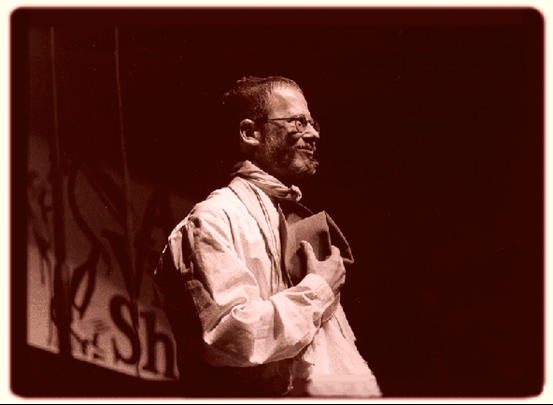
Photo permission by Akasha, Inc.
When the final bar was sounded, Chapin's mother and father, Marjorie and Edward, stood at the apron of the stage, watching their son surrounded by well-wishers.
"His determination to live will pull him through, I hope,'' Chapin's father said.
"I was playing right along with him in my mind because, I wondered if he would have the strength to do it,'' Chapin's mother said of her son's first public performance since last summer. ``It's out of our hands. So we hope for the best.'' ###
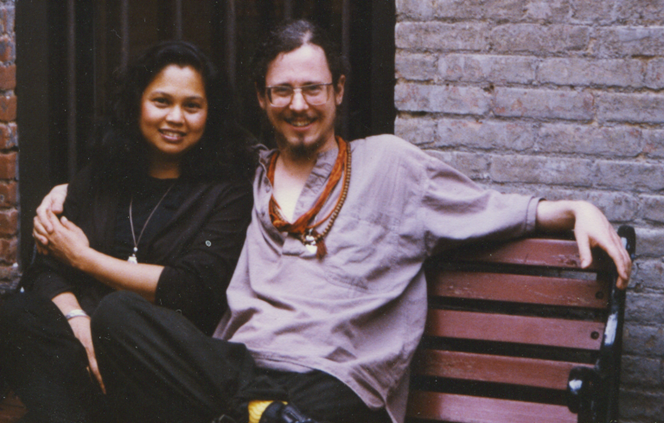
Thomas and Terri, circa 1988 (Photo permission by Akasha, Inc.) © Connie Walker
JOURNEY OF AN ILLNESS
Note by Terri Castillo Chapin: "I'd like to share this timeline for the year of Thomas's illness."
• Late-Jan. 1997 Thomas goes to Africa: Uganda, Tanzania and Zanzibar. It's a personal visit, his fourth trip to the continent where he also meets local musicians. The weather is very hot, and he is treated several times for severe sunburns.
• Mid-Feb. In Zanzibar, Thomas gets sick with fever. Tests are taken, but inconclusive, and he returns home to New York City.
• Mid-Feb.-March Thomas is diagnosed with leukemia and in the hospital undergoes a first round of chemotherapy. He returns home on Easter Friday, fatigued, but tranquil. We are happy and grateful for this time and privacy.
• April -June Thomas has a second round of chemo, then is declared to be in remission. He's told by doctors to play his music, live his life.
• July - Sept. Thomas makes public performance gigs in Canada, New York City and Connecticut.
• Early Oct. Thomas relapses and the leukemia is back. A sad time for everyone and Thomas especially. This time he chooses to undergo a still-new experimental stem cell transplant procedure and returns to the hospital.
• Oct. 15 In a truly beautiful moment, Thomas and Terri are moved to marry in the hospital after a ten-year relationship.
• Late Oct. The leukemia rages and the hoped-for treatment is abandoned. Thomas declines further rigorous chemo. His doctor says, "You've chosen wisely." There are no more medical options. "We're living in the realm of the miraculous," Thomas says to an interviewer.
• Nov. - Jan. 1998 Thomas (and Terri) turns to alternative therapies, experimental drugs and spiritual regiments, including seeing the Dalai Lama's physician, Ven. Dr. Yeshi Dhonden, a Tibetan monk, in New York City. It's all a terrifying walk into darkness, grasping at straws at every turn with no real success. Throughout this time, Thomas, not knowing his end, says, "I love my life. I've had a great life," and pleads many times to me and to his brother Ted, "Don't let my music be forgotten. Keep it going. Keep it out there."
• Feb. 1 Now very much weakened, but lucid, Thomas makes an appearance at a benefit concert for him in his hometown of Manchester, Connecticut. He surprises all and fulfills his long-time wish: 'to play one more time.' On the stage with his flute and reunited with his Trio, Mario Pavone and Mike Sarin, he plays his ballad-composition 'Aeolus' with soaring power and with faltering, too. At the end, with hat to his chest, he bows to the standing audience who are moved to tears. It is to be his last performance.
• Feb. 2 The next day at his parent's home in Manchester, Connecticut, Thomas wakes up with a fever.
• Feb. 3 A day later, Thomas is taken to Rhode Island Hospital. The doctors' shake their heads: the x-rays are dire and show his lungs are filled with liquid. I say to Thomas, in effect, "This time"--there had been many times we had to go to the hospital to check his condition-- "may be a very hard time. I may not be able to get you out of here." That was the way I put it. Thomas looks beatific, serene, and says calmly, "I'm at peace because of Sunday." Meaning when he played "one last time," the evening of the benefit concert. He had been saying many times, "I want to play one last time. I want to play one last time." I'm in awe. What more beautiful place could he be in if he were to leave us now? I feel great solace and comfort. In his hospital room, we say what will be our last "I love you's." I leave the room. The doctors and nurses gather around and attend to him. Thomas slips into a coma-induced sleep.
• Feb. 4-12 The doctors work vigorously each day with different regimens, including experimental, to reverse his condition, but his vitals remain unchanged and he declines rapidly.
• Feb. 13 Ten days later, Thomas passes. His family is gathered around his hospital bed and 'Sky Piece' plays from the recorder.
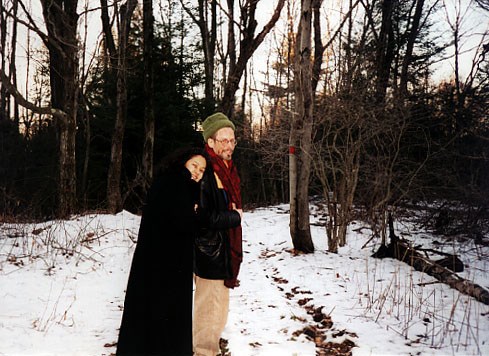
Thomas and Terri, Feb. 1998, toward the end of his year of illness,
just before he performs 'one last time' at the benefit concert in Connecticut
(Photo permission by Akasha, Inc.)
Terri concludes: "It was a long, hard year; Thomas had endured some of the most punishing days a human being could suffer. But his 'warrior spirit,' his courage and determination to live, his hope and his faith --and his humor, too *-- inspired all of us. He was a great musician, yes, but also a profound and compassionate human being and a huge soul. He tried to live his life 'awake' and in awareness that each moment mattered. He practiced resolutely: Be Here Now. And when he made a mistake or fell short, he humbly said, 'I'm sorry. I'll try to be better.' He did and he was. His last words to his fans at each of his benefit concerts were: "Give blood. Give blood in everything you do." This is how he lived not only each day, but to the very end. We all still miss him so very much."
* A big trait of Thomas was his humor, his infectious laughter (he loved to laugh--he loved puns! He loved cartoons!) and his trademark, inimitable, deep "diabolical" laugh (wicked! unmistakable!), his joking nature on and off stage, his "trickster" and "fool" nature, his irony and wit (very quick! and wry, too--and if you could take it and dish it right back, he LOVED that!) was very unique and a special quality of his.

SJU Jazz Festival, April 9th, 1994 © Marinus Lavèn
Quotes over the years by Thomas Chapin:
“Playing, for me, is about changing my state of mind, moving out of my ordinary self. I’ve noticed that when I play, it’s almost like a different person takes over, someone who I don’t deal with in my day to day life, but who is inside me. I try to let this creative force take over. I try not to get too much into my conscious thought. It’s more a matter of setting up conditions—gaining mastery of my instrument, mapping out structures, that kind of thing—that will allow the conduit to open. And when the conduits do open, when that other person takes over, I just sit back and watch the show, and see what comes out. To me, that’s what’s divine about all of this. That’s why I love to play.”
“Compositions are a balance. It’s like saying, ‘for every poison there’s an antidote‘—if a composition gets too sweet, you have to mess it up, on purpose.”
“All my ideas are influenced by my work in Lionel Hampton’s big band, but it doesn’t encompass the whole range of what I do now.”
“The situation [with the Trio] is very freely harmonic. It’s the place where I give my imagination free rein.”
“You need opposition, friction. Without friction there is no heat, no energy, no life. You strive towards higher things, but you also have a body that wants to swing, that has erotic desires, that has to eat. Those are the devils, good and bad, that you should remain on good terms with. Sounds that are nothing but sweet end up not being sweet at all; it’s when they’re bittersweet that they become beautiful… “
“There are a lot of different ways to structure your life and your music. Some people need to define what they are. I don’t. For me, it’s not a matter of negating things. It’s about accepting all that’s out there and selecting….One day last week I worked with Mario Bauza’s Afro Cuban Orchestra, recorded a demo tape of flamenco with a chamber ensemble for a Spanish dance company, and played Argentine jazz with Avantango at the Nuyorican Poets Café.”
“Once in a while I like to listen to polkas—that’s no sin.”
“If I look at my life, it’s improvised in a way. All my art is improvised so I try to find a less deliberate way of doing things. I do a certain amount of work. When I play, I want to play. I don’t want to play anything contrived.”
“If I’m really going to be a ‘free’ musician, I should be free to do whatever I want to do. I should be able to step in and out with equal facility. If I want to play it all inside and it feels good, then why not?”
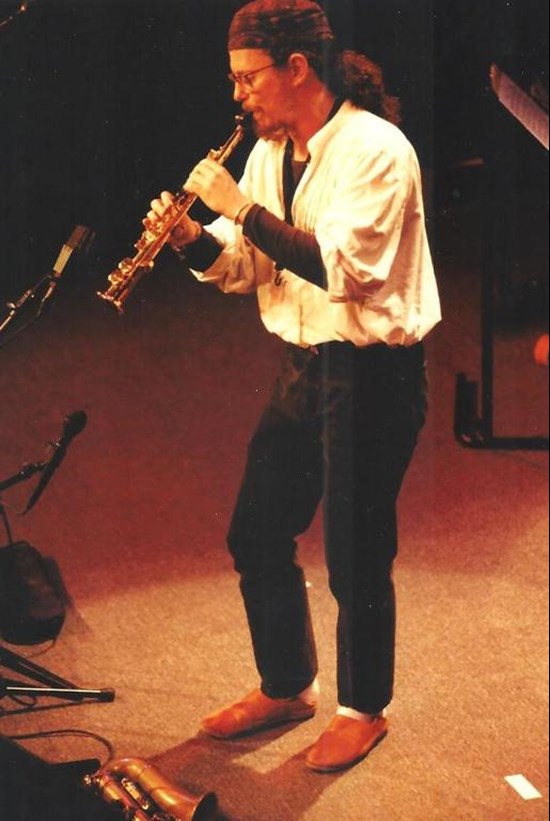
SJU Jazz Festival, April 9th, 1994 © Marinus Lavèn
Thomas Chapin, 40, Raucous Jazz Musician
By PETER WATROUS FEB. 15, 1998
Thomas Chapin, one of the more exuberant saxophonists and bandleaders in jazz, died of complications due to leukemia on Friday at Rhode Island Hospital in Providence, said a friend, Sam Kaufman. He was 40.
Mr. Chapin was one of jazz's more extraordinary musicians. A typical solo of his moved easily between traditional jazz and the sonic explorations of the avant-garde, and in concert he was a showman, using yells and roars and howls to charge his performances.
Mr. Chapin was a fan of two of the more raucous saxophonists in jazz history, Rahsaan Roland Kirk and Earl Bostic, and he approached his shows in part as theater. None of his extroversion diminished the sense that Mr. Chapin was deeply studied, and in his playing one heard everything from folk music of the world to be-bop, from classical music to early jazz. And Mr. Chapin was one of the few musicians to exist in both the worlds of the downtown, experimentalist scene and mainstream jazz.
He came to his breadth of knowledge naturally. Mr. Chapin began his serious studies in the early 1980's, attending the University of Hartford and studying with the saxophonist Jackie McLean. He later graduated from Rutgers University, after studying with the pianist Kenny Barron. The schooling he received allowed him to take over the leadership of Lionel Hampton's orchestra for six years, starting in 1981, and also maintain a position in Chico Hamilton's band as a saxophonist.
But Mr. Chapin had other ideas, and in the late 1980's he formed his own groups, most notably a trio with the bassist Mario Pavone and the drummer Steve Johns. And he entered the fertile world of the Knitting Factory; Mr. Chapin was the first artist signed by the club's record label, Knitting Factory Records.
For nearly 10 years Mr. Chapin pursued his own music, working with the trio at festivals and clubs around the world, and also arranging larger groups. And he spent a good portion of his time working with the more important names in various factions of jazz. He performed with John Zorn, Dave Douglas, Ned Rothenberg, Marty Ehrlich, Ray Drummond, Ronnie Mathews, Peggy Stern, Tom Harrell, Anthony Braxton and many more.
Over his career Mr. Chapin recorded about 15 albums; his most recent, ''Sky Piece'' (Knitting Factory), a trio recording, was recently released.
He is survived by a wife, Terri Castillo-Chapin of Queens.

FILM ABOUT THOMAS CHAPIN & ADDED RARE FULL PERFORMANCES
Here's the content breakdown for the 2-disc CD, 6 hours, total:

Disc 1:
- The 96 min. version of the film
- The 2 min. film's trailer
- The deleted scenes (25 mins.) featuring
- US & Europe tour;
- The Netherlands tour;
- The Thomas Chapin Quartet;
- What is Jazz Debate;
- Thomas & Bebop;
- Thomas's Legacy.
- Live Trio Recording Session with Michael Sarin on drums (1 hr.)
- Terri Castillo Chapin's short documentary about Thomas, DANCING CHICKEN MAN (10 mins.)

Disc 2:
- Uncut interview for the film with Mario Pavone, bassist for the Thomas Chapin Trio (150 mins.). Trio, Thomas, jazz, Mario history galore! A feast of great stories and information.
- Live performance at the Knitting Factory with Thomas Chapin Trio with Steve Johns on drums. (1 hr.)
WHERE TO BUY?
- For the Special Edition, 2 Disc, DVD, go to Moviezyng.com -- $20.99
- For Downloads or Rentals (but no special/extra features this is just the film), go to ITUNES to View ($4.99) or Buy ($14.99)
- Or buy the DVD in U.S. at: Barnes and Noble ($21.99) & Best Buy ($19.99)
The special additional features, including rare live performances of the Trio, informative lengthy interview with Mario Pavone, etc., are not included in digital downloads when viewing the film at iTunes, Amazon Prime or other digital download platforms. Best to buy the Special Edition DVD hard copy with extra content at Moviezyng.com or see more at nightbirdsongfilm.com to buy, download/stream and other facts and commentary.
Customer Reviews 5 STARS
A powerful doc on a master musician
by TheKuttleFish
"Having been a fan of Thomas Chapins since his death, I was very much looking forward to the opportunity to watch this film, and it in no way disappointed. Watching his final performance moved me to tears. Highly recommended, especially for those who don't know his work, you're in for a wonderful, perhaps life changing, surprise."
___________________________________________________________________________________
Film credits:
Stephanie J. Castillo (3/21/1948 - 3/8/2023), filmmaker, Thomas Chapin, Night Bird Song: castillosj@aol.com
Watch the film's trailer: www.thomaschapinfilm.com
You'll find a very complete discography by Emanuel Maris here: https://en.wikipedia.org/wiki/Thomas_Chapin
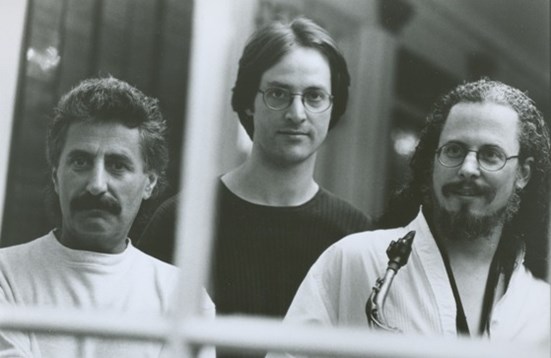
THOMAS CHAPIN TRIO: Mario Pavone, Mike Sarin and Thomas Chapin
(Photo permission by Akasha, Inc.)
NOTE: Besides the Alive 8-CD box set which contains all of the Thomas Chapin Trio music that was released by Knitting Factory Records, 1998, --This music is now owned by Thomas Chapin's non-profit, Akasha, Inc.-- there are two other posthumous releases:
1. Ride (Playscape Recordings), 2006, is the first live European Trio concert ever released of a performance at the North Sea Jazz Festival, 1995, The Hague, Holland, with Thomas Chapin, alto sax and flute, Mario Pavone, bass and Mike Sarin, drums.
2. Never Let Me Go, (Playscape Recordings), 2012, is a 3-CD set of Thomas Chapin last quartet performances in NYC in 1995 and 1996. Disc 1 and 2 are from Flushing Town Hall, Queens, NYC, Nov., 1995, with Thomas Chapin alto sax and flute, Peter Madsen, piano, Kiyoto Fujiwara, bass, and Reggie Nicholson, drums. Disc 3 is from the Knitting Factory, NYC, Dec., 1996, with Thomas Chapin, alto sax and flute, Peter Madsen, piano, Scott Colley, bass, and Matt Wilson, drums.
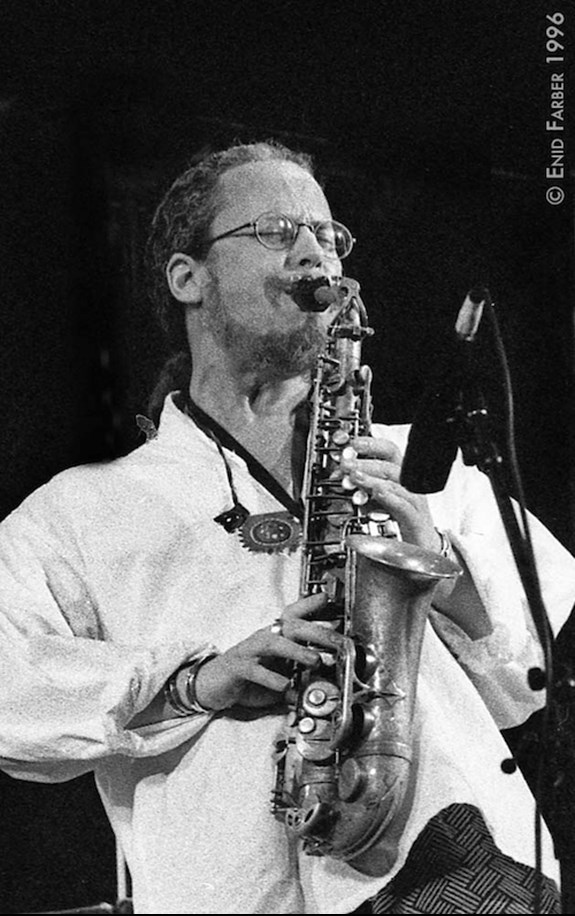
1996 © Enid Farber (Photo permission by Akasha, Inc.)
Quotes from Colleagues and Friends:
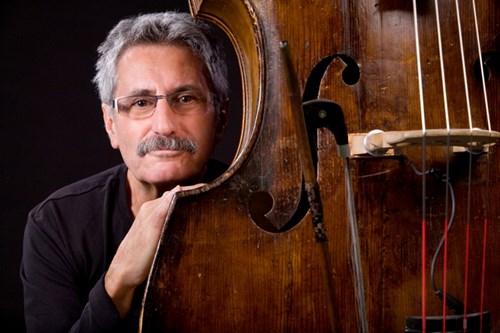
Mario Pavone © Steven Laschever
I first met Thomas in the summer of 1980 at a Big Band Mingus Tribute Concert at Buhnell Park in Hartford, Connecticut. The band was stocked with A list New York players (Junior Cook, Bill Hardman, Ray Copeland and others, as well as the most prominent musicians from Hartford (Paul Brown, Peter McEachern, Mike Duquette, Joseph Celli and others). Each time Thomas stood up and soloed , the huge crowd went crazy .. Roaring with wild applause !! I was blown away ! We met after the performance and thus began our 18 year adventure filled journey together. During all those years he never played with any less brilliance, virtuosity, energy and emotion than he did that summer day.
His fiery genius, deep commitment and strong taskmaster qualities led the defining Trio ... with Mike Sarin and myself, to worldwide critically acclaimed performances until his tragically early passing.
Mario Pavone

Michael Sarin © Jacky Lepage
The time I spent with Thomas and the Trio playing, traveling, and sharing a friendship was truly a joy and a blessing. He embodied most of what I sought out in New York City's jazz and improvised music community: an openness, curiosity, and willingness to embrace any-and-all musical styles and influences in forging a unique and personal voice and artistic vision.
I found Thomas to be comprised of many facets, some at odds with one another from time to time. His constant dedication to availing himself of the creative spirit, and the ensuing artistic output thereof, were a way he made sense of these various aspects. And the results were thrilling and powerful for all who saw or heard him perform; or viewed his collages; or chatted with him about any of his myriad interests.
He was a traditionalist; highly creative; rigorous; restless; intelligent; generous of spirit; curious; proactive; loyal; vulnerable; disciplined; AND he loved to laugh!!!!
Of course, we all miss his music--well, the music he would be making if still alive today. But those who knew him miss Thomas, the person--his friendship and laughter. He was a true artist and unique spirit!
Michael Sarin
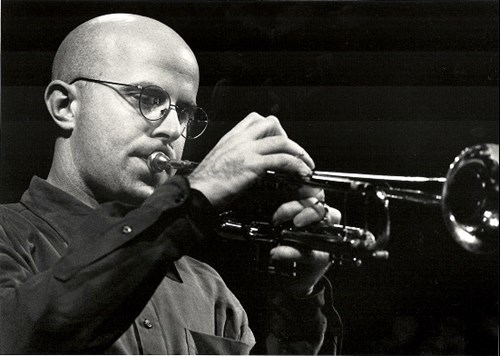 Dave Ballou © Jacky Lepage
Dave Ballou © Jacky Lepage
Thomas Chapin, to me, was an example of what jazz musicians of his generation have become: musicians of broad influence, depth and scope. I do not recall if I ever met Thomas. In 1994, I moved to Brooklyn to engage the creative music scene developing at that time. Thomas was one of the people that participated in the music developments that have become identified as downtown (Knitting Factory et al..) but he was not afraid to show his mainstream influences. Through my associations with Thomas’s bandmates and by arranging his music for several tributes surrounding the release of the film, I am stunned by his energy, enamored with his recordings and grateful for his drive and commitment to the art of improvised music. We can all learn from Thomas to trust our impulses and to have the courage to live creatively.
Dave Ballou
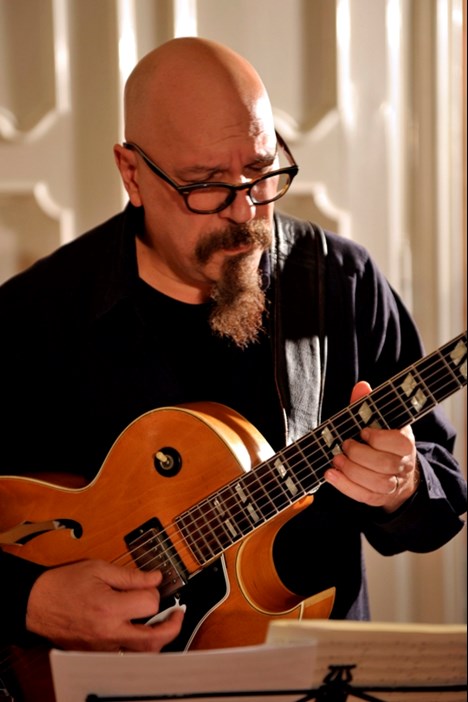
Michael Musillami © Simon Attila
So much can, has, and will be said about Thomas Chapin. Many layers, and like all of us, many Thomas's under one skin. So, I'll pick two pieces of how I frame him in my mind.
First, EMOTION: He seemed to channel his emotion, undistracted by outside influences, but still consider what was around him before, during, and with foresight, after. For me, this is the essence of it all. The music learning is just a vehicle for emotion. Some write, some run, some tell jokes, TC did it through music, his way. We all do it, just in a different way.
Second, SOUND: His sound was singular. His. The music voice. Was he the greatest saxophonist ever? Yes? No? It doesn't matter. He was TC. He had his voice and a story to tell while he was here. I believe he knew his time was limited. We know these things. Our body tells us in subtle ways.
He was my friend, teacher, and one of the cats.
Michael Musillami
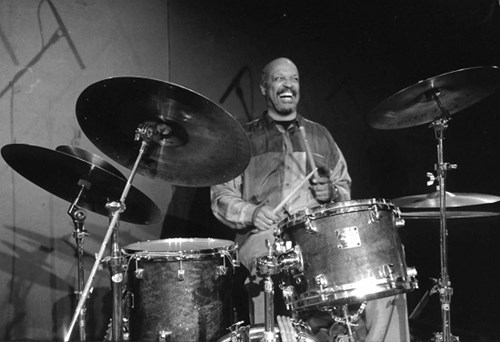
John Betsch © Jacky Lepage
I can't remember exactly how we met but several things stick out when I think of him. The first, of course being the spirit of his sound: so many saxophonists but so few with real identifiable spirit to their sound and Thomas always stuck out that way. We did gigs with bassist Mario Pavone in Connecticutt where Mario lived and a recording in New York with Ronnie Mathews, the late underrated pianist. I've lost track of Mario but he might actually have some recordings of our gigs together.... Thomas's joyous enthusiasm was infectious: I remember driving with him and Mario to a gig with Thomas raving in the back seat about all the different ways of playing and Mario and I delightfully amused!
It's very difficult to say in words the magic of Thomas's spirit but thankfully he left us with wonderful recordings and I'm very proud to have participated in one.
John Betsch
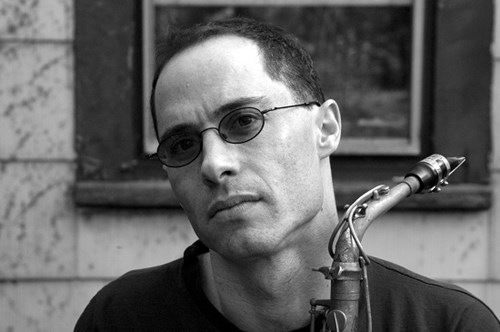
Ned Rothenberg © Caroline Forbes
It's common with creative artists to talk about the love they put into their work. This 'love' can mean many things - care, focus, commitment, curiosity. Thomas's musical voice had all these things but it also brought love in its most direct romantic sense. He was 'in love' with music and the vast realm of the sounds he could make and the sounds around him. This was so direct that it joined the idiomatic (jazz and the many other styles he mastered) with the universal (the joy of listening to nature and the human cacophony) so that, sophisticated as he was musically, a pure and tremendously attractive childlike wonder remained.
From the liner notes from the Double Band CD “Parting”:
… Thomas was a rare fellow, highly intelligent, full of arcane knowledge (“don’t be trying to help me with this crossword puzzle“), a searcher after all those unknowable truths, and yet beneath it all, not really an ‘intellectual’ in the conventional sense. He would always rather just do something than talk about or around it. Just like his playing, always direct, just what it was, the man singing, the pure improviser.
Ned Rothenberg
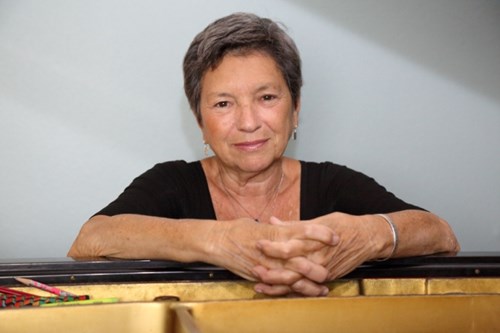
© Peggy Stern
… people ARE how they play. Thomas's music was fresh and pure, spontaneous and generous of spirit … He was a bundle of energy, all the time … So devastating was his torturous last few months and his death, because he was such a ‘live’ person – so fun, and silly, and serious, and just full of music and piss and vinegar …
Peggy Stern, pianist
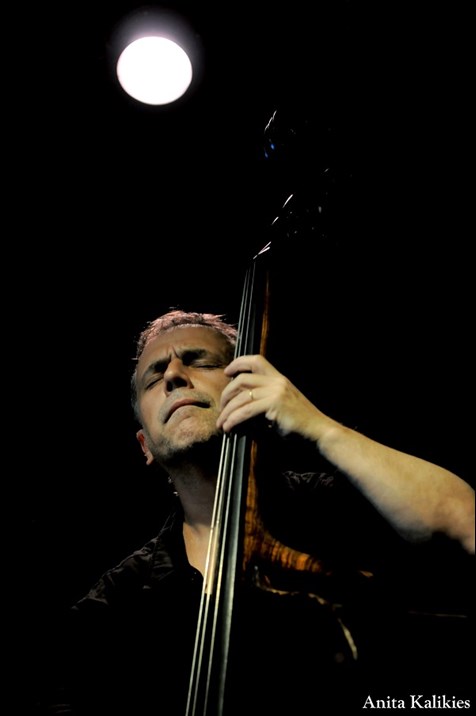
Pablo Aslan © Anita Kalikies
Thomas was monumental, as time goes by I grasp the enormity of his talent and spirit (and Stephanie Castillo’s film, Night Bird Song, was great help to understand him!). I was lucky to encounter him, he pushed my boundaries, or as we say in the music world, he kicked my ass!
Thomas remained voraciously interested in the musical language that I was introducing him to. He absorbed the phrasing style, and he discovered a way into this music from his own creative source as well. This appetite and this ability to turn the language around and make it his own was very inspiring. There was no question that he was right there with you every time you played. His commitment to making music was complete.
Pablo Aslan
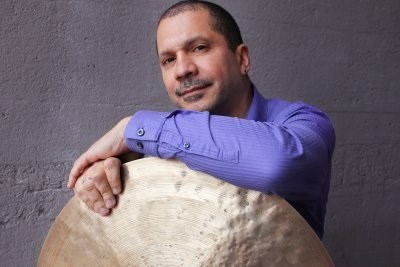
Steve Johns © Chris Drukker
The first time I recall meeting Thomas Chapin was at a Lionel Hampton audition at Carroll Studio’s in NYC around 1989. I don’t have much of a memory of the encounter except that Lionel kept knocking his Pepsi off his vibes with his mallet and Bill Titone his manager would replace it and Hamp would knock it off again. Thomas was leading the saxophone section and smiled a lot. Thomas was encouraging to me during my audition. I didn’t see Thomas again for a while until I got a frantic phone call from him one afternoon telling me that his drummer Pheeroan AkLaff wasn’t able to make the gig at the Knitting Factory that evening and asked if I would be able to make the gig. At this time in my life I was really trying to be a mainstream jazz drummer so Thomas’ music was everything but that and would be a real mind bending and challenging experience for me. I showed up to the Knitting Factory and met the great bassist Mario Pavone “now one of my dearest friends” for the very first time and we began to rehearse the compositions that we would play that evening. Right away from the very first note we had a vibe and I knew that this was going to be a great night. We played to an enthusiastic crowd and the Thomas Chapin trio was born! Later that year A&M Records released a compilation CD Called Live at The Knitting Factory Vol. 3 and one tune “Insomnia” from that very first gig with Thomas was chosen to be on the CD. I didn’t know that my first gig with Thomas had been recorded but there it was the very first official recording of the Thomas Chapin Trio!
Thomas was such a fun person to be around always cracking me up with things he was thinking about. But he had another side to him that was very serious and he was demanding of our attention at rehearsals having a very specific approach to composition “a task master” as Mario Pavone would always say.
As a result of this release of the “Live at the Knitting Factory” CD we started doing tours of Europe and Thomas’ trio was on its way.
Thomas Chapin was one of the finest musicians I’ve ever known. A true master of the saxophones, flute, various miscellaneous instruments and a very special person in my life. I will never forget him.
Gone way too soon.
Steve Johns, drummer

Peter McEachern © Steven Lashever
I still feel Thomas Chapin’s spirit in my life, hear his music, and laughter. Hanging with Thomas was always a high voltage experience whether on or off the bandstand. Thomas “was” music and wherever he found himself it became a musical experience. His palette was wide open, certainly the concert setting whether mainstream or avant garde, but also finding pipes that produced tones in an abandoned industrial site, or novelty instruments at toy stores. Thomas allowed me the space, to feel I could contribute to the moment and encouraged me along with countless others to develop my voice. I was also amazed not only by his musical abilities but by his sensitivity and support for all those around him. I often call on my memories of our many gigs and hangs to help inspire me. I feel fortunate to have played and recorded with him, and to have had many late night talks about music and other mysteries. We are lucky he left us with a body of recorded work so all can hear his brilliance, artistic integrity, and get a glimpse of this champion of the creative spirit. I am reminded of just how much I miss him as I write this.
Peter McEachern
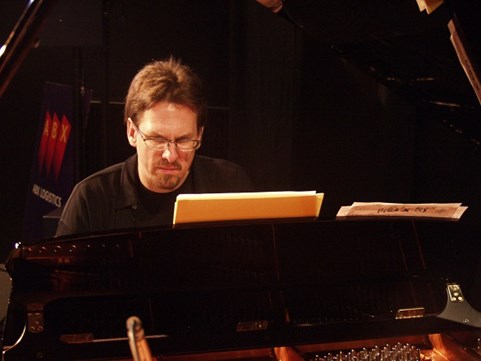
Peter Madsen © Jacky Lepage
Thomas Chapin and I first met at my apartment in Brooklyn in the mid-80s through bassist Kiyoto Fujiwara. How lucky I am to have spent so much time together playing and talking and laughing with this wide-open musical genius! Thomas was truly one of the finest creative musicians I ever met in my life! He could have filled a stadium with his energy for music and the full spectrum of life! His love of everything to do with music and improvising effected everyone around him...including me. I'm sure in the years that he has been gone he has been busy inspiring the Gods with his joy and visions of a better world full of improvised music for everyone! I miss Thomas everyday!
Peter Madsen

Armen Donelian © Stephen Donelian
Thomas Chapin was my good friend for several years until his untimely passing in 1998. I met him, I believe, in 1987 or ’88 while performing at Visiones Jazz Club in New York City with Night Ark, a Middle Eastern Jazz fusion group led by oudist Ara Dinkjian with whom Thomas attended Hartt School of Music. Thomas approached me in the club and after speaking together for a few minutes we felt an immediate connection. We decided to get together to play, and soon we were doing gigs together, both in his bands and mine. In his bands, usually it was with Mario Pavone or Kyoto Fujiwara on bass and Steve Johns or Mike Sarin or Reggie Nicholson on drums.
What made playing with Thomas so special for me was the immediacy, passion and joy he exuded in every note, not to mention his utter technical mastery of not only the alto saxophone but also the flute, his first instrument. This places him, in my opinion, in a league with the very finest of Jazz flutists ever to have played that instrument.
On a personal level, I felt a kinship with Thomas that embraced non-musical interests in areas such as politics, philosophy, mysticism, meditation and world culture. When I suffered a traumatic injury to my hands in 1991 requiring surgery and an extended recuperation, Thomas was the only person who visited me during my convalescence to offer some cheer and laughs.
A highlight of our professional work together was a two-week tour of France as a member of Thomas’ quartet with Pavone and Sarin in 1991 shortly after my injury, including a concert in the Toulon Jazz Festival. Another highlight was a live 1992 recording of my quartet at Visiones with Thomas and bassist Calvin Hill and drummer Jeff Williams. This music was eventually released under the title Quartet Language on the Playscape label, and received glowing accolades.
I will always remember Thomas’ humor, humanity and kindness. The fact that he was a complete musician with whom I shared significant history only adds a sense of pride and accomplishment to the essential friendship and mutual respect underlying our collaborations.
Long Live Thomas!
Armen Donelian
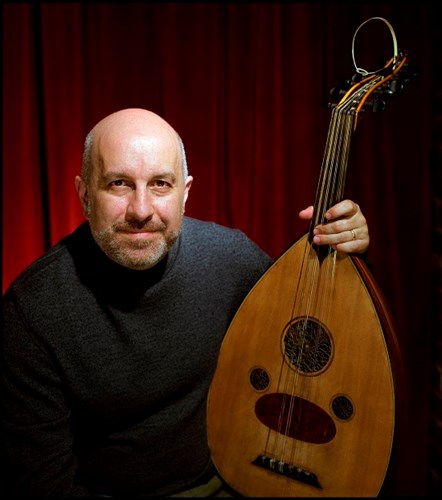
Ara Dinkjian © Kendall Messick
I first heard Thomas Chapin in 1976, as a freshman at Hartt School of Music. He was one of the soloists in the school’s jazz big band. I was not a fan of jazz at that time, but when Thomas stood up and played, something magical happened. His energy, freedom, unselfconsciousness, and sheer joy shattered all categories and subdivisions of music and art. I was so taken by his music that I did something I have rarely done: I went backstage to meet him. I told him how much I enjoyed his performance, and introduced myself as an oud (fretless middle-eastern lute) player. Although he was polite, I was left with the feeling that the jazz fraternity is an exclusive club!
Nonetheless I continued to follow and admire his progress, which eventually provided him the opportunity to travel around the world. A few years after our first meeting, to my utter surprise, he knocked on my apartment door, and asked if we could talk about world music! Soon after that, he began inviting me to play with him at his club gigs, concerts, and recordings.
Playing music with Thomas was both thrilling and intimidating, as he forced me to stretch my own limitations.
However, my most precious moments with Thomas were our countless hours talking, about everything. He was so curious and confused about life, and yet at the same time he was so sweet, generous, and child-like. Of course, this all came through loud and clear in his music.
There is nobody like him. I miss him. I’m so grateful to have experienced his magic.
Ara Dinkjian
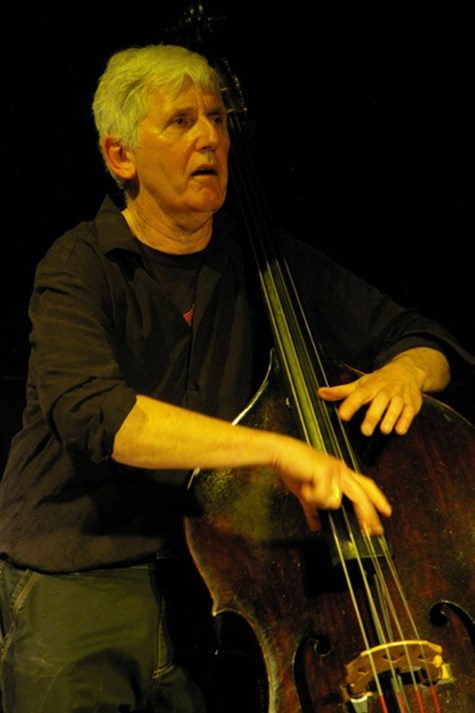
Mark Dresser © Susan O’Connor jazzword.com
I personally liked and admired Thomas Chapin, though I had had no musical interaction with him. I became aware of him through his performances at the Knitting Factory and our mutual musicians friends, Ned Rothenberg and Michael Sarin. When I learned he was sick I visited him in the hospital and as I had a car I could offer to help out with some medical appointment. The connection was a predominantly a human one and recognition that Thomas was a warrior musician, virtuoso saxophonist, who could write memorable tunes and as a performer gave all at each gig with a level of virtuosity, energy and spirit. His demise was a real loss.
Mark Dresser
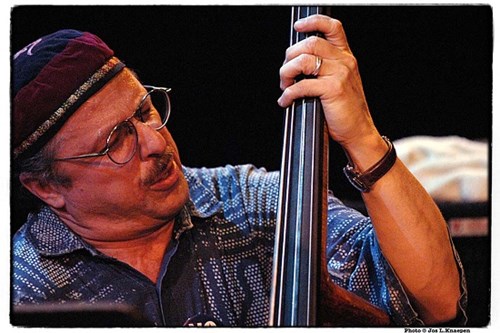
Joe Fonda © Jos L. Knaepen
I know Thomas from the scene in Hartford, Connecticut. I was living there and that's where he grew up. So we were playing at the 880 Jazz Club in Hartford together very often. We were in a few big bands together. He also participated in my Kaleidoscope Ensemble, that had a painter, a dancer, a sculpturer, an actor, a cook, and 4 musicians. They were doing their thing at the same time.
In January 1992 I joined Thomas Chapin at a two weeks tour in Spain. Carlo Morena was on piano, drummer was Fernando Llorca and Jorge Pardo played tenor and soprano saxophones and flute. I still have a tape from the gig in Zaragoza (Centro Civico Delicias, January 11th). That was quite a concert. As always, playing with Thomas was very energetic and very inspiring to me.
We were good friends.
Joe Fonda

My friendship with Thomas goes back to 1977, my freshman year at the Hartt School of Music in Connecticut. He was still called ’Tom’ then. He was two years older, and our birthdays were two days apart. We became friends immediately and he began to introduce me to players on the jazz scene in Hartford at that time. I often accompanied him to gigs. He played all kinds of music, including completely improvised concerts with Zasis, a collective with Thad Wheeler, Bill Sloat and Rob Kaplan. This group in particular had a profound effect on my musical understanding, and Thomas' personal aesthetic regarding music and sound was revelatory for me.
In the 1990’s, while I was living in Manhattan and Thomas was in Queens, he began studying with a spiritual teacher named Gil Barretto. Gil admired Thomas’ music and was a saxophonist himself. Gil later became my husband.
One day, long after Thomas had passed away, I realized it was he who first pointed the way. He showed me how it was possible to access the infinite realm of sound, like an Explorer, and bring back treasures from those journeys that you could share with others through your music.
Thomas did what he came here to do. I’m sure his life and music will continue to be inspirational for many musicians, and artists of all kinds.
Su Terry
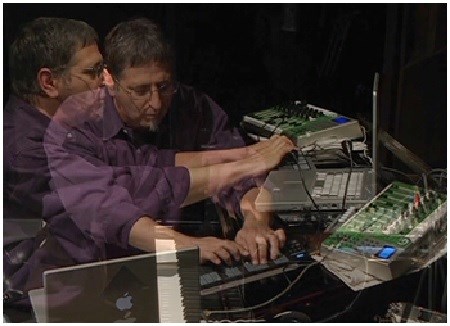
© Courtesy Robert Kaplan
I first met Thomas in 1976 when looking for a practice room at Hartt School of Music. I heard someone playing the hell out of Giant Steps on piano. Through the window I saw a head of wild black hair, body swaying as he played…and I had thought he was a sax player! Each Sunday we would set up a huge array of instruments in Bliss Auditorium at Hartt and play for hours. We became a quartet called Zasis — Thomas on woodwinds, artillery shells, bird whistles and toys, Thad Wheeler on percussion, strings of wrenches, bundt pans, and a kitchen sink, Bill Sloat on double bass and electric bass, and me on acoustic and electric keyboards, tape recorders, and misc. percussion. Performances were totally improvised. Over the eight years we had developed ensemble thinking rehearsal strategies and compositional sense that served us all well.
In Thomas’ words: "Our music tells stories, paints pictures. It creates new worlds. You become a leader and a follower...If anything has given me spiritual enlightenment, or direction in music or helped my musical awareness, Zasis has been my source." - (Interview by Phil Tankel, Hartford Advocate, 1977)
Often we would finish playing a piece and we’d all wonder where that came from. Chapin would then shriek out laughing. These became known as Zasisizations.
In my last conversation with Thomas he had resigned himself to the fact that his survival was out of his control and in God's hands. Even then he kept saying that we have to do a CD. He emphatically yelled into the phone, "ZASIS LIVES!"
He’d be happy to see many of our techniques devised for rehearsals being used at Arizona State University in transdisciplinary improvisations.
So glad Thomas is coming back around in this way. I think of him so often.
Robert Kaplan

Vernon Frazer © Jonathan Duboff (Courtesy Vernon Frazer)
After hearing my first set of Thomas Chapin late in 1980, I asked myself, “Why isn’t this guy famous?” To my ears, Thomas was one of the most original and accomplished saxophonists to play in the 1980s and 1990s. Nobody I’ve heard since has equalled or surpassed him in skill or inventiveness. Thomas not only possessed a distinctive style; he possessed listening abilities that enabled him to blend with any musical situation in a protean manner while projecting his singular musical personality within the context of the performance. When he and I performed as a duo in the early 1990s, I never had to tell him what to play; his grasp of my poetry and his ear for music enabled him to play parts that sounded far better than any I could have created for him. He was one of the most complete musicians I ever heard. He was also a dear friend, whom I miss very much.
From the text from ‘Put Your Quartet In And Watch The Chicken Dance’ on “Menagerie Dreams”:
In the Houston Street performance space his fingers weave flute-sounds over the toe-dance that syncopates his beat.
Vernon Frazer, poet-bassist
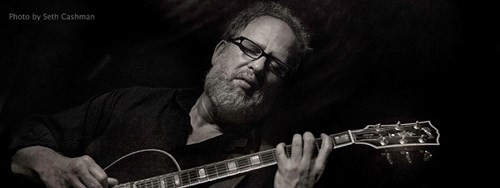
Saul Rubin © Seth Cashman
Thomas Chapin was an incredible instrumentalist and composer. He stretched the boundaries of style and was enigmatic in that way. He really knew Jazz, meaning straight ahead jazz, but also embraced free jazz as well as Brazilian, Tango , Flamenco, Salsa, etc.
He played flute like no other and his alto sound was strong and unmistakably recognizable, an unusual thing in the days of clones and imitators. When he was playing strong it was with tremendous energy but his ballads would make anyone close to tears.
I knew Thomas from Hartt College of Music in 1976. He was way ahead of everyone on his instruments and conception. He later went on to Rutgers University. For a few years in the late 80's he had me in his band Spirits Rebellious. These compositions were very influenced by Brazilian music especially Hermeto Pascoal. After that group he went on to from his trio which was his primary group till the end of his life. He died way too young but left a great body of recordings and compositions. His sister in law's documentary film really captures Thomas as he was.
Original bassist and friend from Spirits Rebellious, Arthur Kell and I have recently started playing again as Spirits Rebellious , playing the original tunes Thomas wrote during that period. We are revisiting these great compositions with percussionist and original member Joe Cardello, drummer Mark Ferber and saxophonist Stacy Dillard. The band is different without Thomas but still very exciting.
Saul Rubin
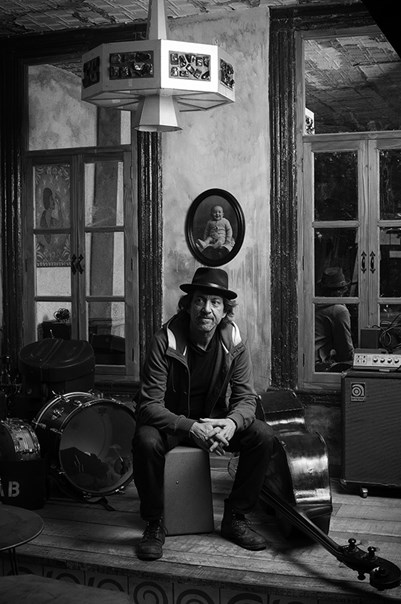
Arthur Kell at Bar Lunatico in Brooklyn, NY © Skyler Smith
I met Thomas when we were fifteen and just students at a private school. From the first note, his playing knocked me out. Everyone at the school stood up and took notice and never forgot. He was astonishing — his connection to the music was already fully formed. For some reason we bonded deeply and it lasted a lifetime. We improvised into the night on anything and everything: standards, Stevie Wonder, free music. He was possessed even then.
Thomas had it all: heart, energy, sound, technique, concept, humbleness. He was a deeply thoughtful person, a deep well of sensitivity, on and off the bandstand. And his commitment to music was so innate and profound that anyone listening couldn’t help but hear it. Out flowed something spiritual, something with humility. The tremendous strength in his music derived from that foundation. And he could have so much fun with music that it infected you. There was an indescribable, piercing beauty to his playing. It was there as a teenager and it was there the last time he played. He was seventeen when he said to me: “Always create something with your music. Keep your original music happening. Always be creating.” That advice stayed with me all my life.
Arthur Kell
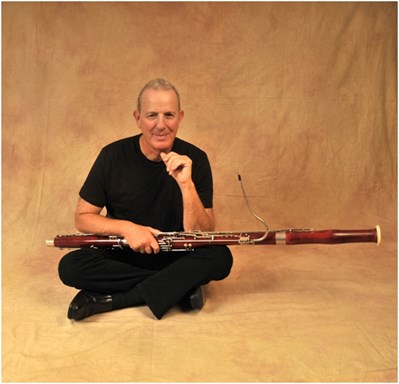
© Jennifer Van Sickle
Tom (Chap) as we called him in Connecticut where I met and heard him with Mario Pavone groups playing in Hartford and Waterbury was a constant source of inspiration to me. I marveled at the intensity of his playing both on alto and flute. He also brought any group he played with up a notch in terms of energy and creativity. His precocious curiosity of the world around informed and influenced his music profoundly. Our collaboration in the mid 80's playing regularly at the 55 Bar in Greenwich Village allowed me to respond to and be part of that "Chapin" energy and exploration. Playing with Tom was an exhilarating ride. One morning after an evening of intense playing I was compelled to call him because I felt I had to tell him how privileged I was to have taken this intimate musical journey with him. That feeling I had that morning is still fresh and as palpable 30 years later.
I loved Tom and blessed to have been there on the scene with him.
Michael Rabinowitz
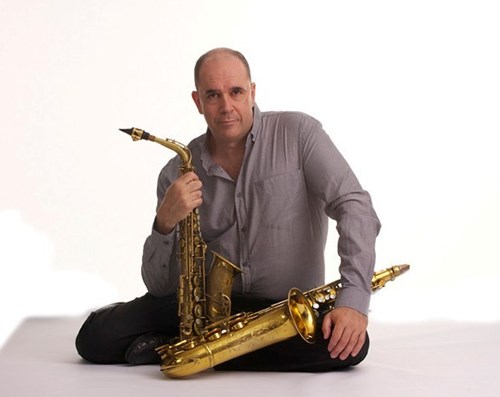
Courtesy Adam J. Brenner
I first met Thomas Chapin when I got to Rutgers/Livingston College in 1978. I was really impressed with his playing and his sight reading skills. In the student big band led by Paul Jeffrey, we had a lot of very difficult music to play and Tom (I knew him as Tom) would always be reading through most of the parts right from the first time when the rest of us would be just hanging onto a few notes.
He was very passionate about music and his excitement and interest in all kinds of music was infectious and I loved his spirit. He and I would hang out socially and he turned me on to many artists I didn’t know about including people like Frank Strozier and Roland Kirk. I had heard of Roland, but didn’t really get into his music but Tom encouraged me to listen to everything without judgement.
I loved listening to Tom’s solos and especially loved his flute playing. He had a lot of interaction with alto saxophonist and flutist James Spaulding, who was one of Thomas’ primary influences at the time who was very much on the scene at Livingston.
Tom graduated a couple of years before I did and when I graduated, a couple of months later I joined the Lionel Hampton band and played next to Tom in the reed section until he left to begin a solo career in 1986. Tom quickly rose to prominence and it was gratifying to see his acceptance in both the straight-ahead and the so called “avant-garde” or free-jazz audiences. I know he was a one of a kind artists with tremendous abilities to incorporate all of his varied influences into a blend that was uniquely his own and had a true commitment to making music his way yet he reached people at a very deep level.
He didn’t give me much advice, but occasionally would say things that stuck with me and I knew he and I shared a great respect for each other’s playing. I know we won’t see anyone like Thomas Chapin ever again and I know his music will endure and even though his life was cut short in his prime, he left enough music with us to prove forever that he was a major creative force that set the bar extremely high for all of us to be inspired by and challenged by.
Adam J. Brenner

Thomas and Allen Won w/ Shunsuke Fuke on drums (CPhoto: courtesy Allen Won)
(Kiyoto Fujiwara, bass and Peter Madsen, piano also played at this Kiyoto gig.
I don’t know what I can say that has not already been said about Thomas Chapin. You have so many great musicians from his life recounting his accolades in spades. All I can say was that he influenced and inspired me and still does to this day. His music and his playing were some of the greatest and most memorable moments in my musical life and he helped nurture a passion for the pursuit of beauty in everything I do.
He was a renaissance man of a sort. In everything to do with music, in every object he found he saw the potential of a sound, a voice to make heard. And he would make it happen. I felt as though Thomas was creating history with what he composed and played. His influences and musical tastes were vast and yet he made it all seem so obvious and simple.
One of the times at the original Knitting Factory, I burst out laughing during Thomas’ set. Afterwards, I went to speak to Thomas and apologize for my out burst but Thomas looked at me with his characteristic smile and said, ‘no man, I dug it cause I knew you got it’.
It took me a good 15 years before I could speak of Thomas without breaking down.
His passing is still unbelievable to me but I accept it now. I still miss my friend.
Allen Won
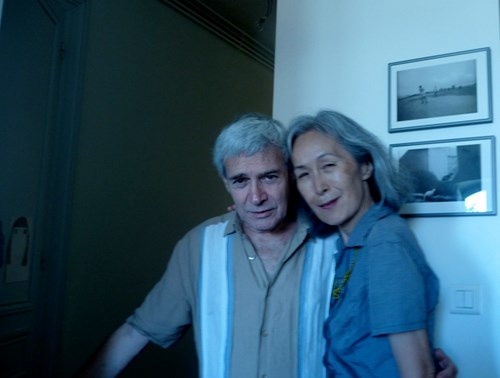
Steve Dalachinsky & Yuko Otomo © Appoline Lasserre
Lines for TC
(trippin’ on Chapin)
Thomas Chapin: reed player / flutist / composer / visual artist / collagist / poet / mentsch / everyman \ renaissance man / musicians ‘s musician / warm heart true friend / whom i love & miss & think of every day >
Thomas Chapin: seeker / innovator / faithful forgiving formidable soul >
Thomas Chapin: the ears of music when the husks are stripped away /
the voice that resonates when the duet is in disjunctive harmony
bras(s)h sweet kernels
i speak to you as you speak to me
this sound we hear that is one in us all
& all the silence & all the taste & touch & scent & sight
that is all this very big/small WORLD
i could if i could play
music could if i could say
music would this way that way
the way the fingers dance
the way the singer takes a chance
&
i should
if i could & i would
if i could
play music
say music
be
music
see music that music would be you…
Steve Dalachinsky, poet
Thomas Chapin lives in us, not as a memory but actually as a wholesome existence, not just as a musician in a narrow sense of the labeling category, but as a cosmic total being. His angelic personality & his total dedication to what he loved were so genuine & enduring. Music; art; poetry; traveling & adventures… he loved everything life offered him & he loved people he encountered whether it was brief or more involved. We knew Thomas loved us & he knew we loved him. This type of total pure love & friendship does not happen too easily. The most amazing thing about Thomas was that he knew many people & everyone of us had identical reactions to his loving nature. The love between him & us was so real that no one had to claim or to declare it since it was always there in the most natural manner.
Yuko Otomo, poet
Quotes from Music Industry Colleagues and Friends:

Thomas Chapin and Danny Melnick, Japan 1993
(Photo permission by Akasha, Inc.)
Thomas Chapin was a force of nature. He was wild, funny, smart, considerate and an incredible musician and composer. I LOVE his music and thought he was one of the most compelling live performing artists I have ever seen. I had the honor of presenting him in Newport, New York City, Japan and other places. For me, and many others, he stood at the center of numerous disparate worlds of jazz at that time. He was a master of all forms of jazz and maybe proved that these "schools" or "styles" weren't so different at all. He left us way too soon and for those who knew him, saw him play and know his music, he will be with us forever.
Danny Melnick
President - Absolutely Live Entertainment
Danny Melnick is a festival, tour and concert producer and at the time was working with George Wein's Festival Productions, Inc. Danny was one of the people who booked Thomas at some of the larger festivals for the first time. Danny knew that Thomas belonged on the big stages such as the Newport Jazz Festival, the Madarao, Japan Festival and the JVC Jazz Festival in NYC.
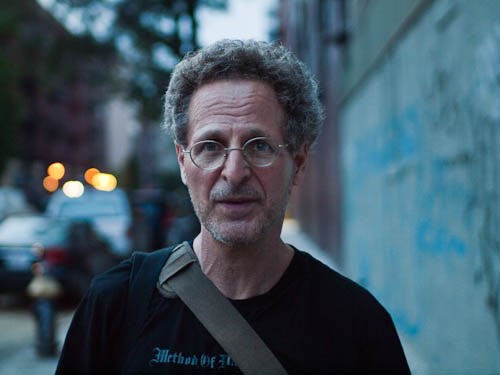
Bruce Lee Gallanter © Courtesy Downtown Music Gallery
I met Thomas Chapin in the mid-1980’s when a poet friend of mine named John Richey organized a band with former students from the Rutgers Livingston Jazz School in New Brunswick, NJ. A guitarist named Bob Musso picked four of his favorite musicians from the school, adding John Richey to sample radio, TV & tapes, as well as spoken word cut-ups. I had already known about Thomas Chapin after witnessing him play with the student jazz ensemble a few years earlier, playing one short solo amongst more than a dozen student saxists and blowing everyone away. The band was called Machine Gun which seemed most appropriate since their sets were an assault on the senses. Combining the best elements of free jazz/rock/punk/funk with Thomas’s alto sax screaming and pushing them higher and higher. Bob Musso soon started a label called MuWorks which I volunteered for. MuWorks released an early Thomas Chapin record called “Radius”, which I wrote the liner notes for and which remains one of the undiscovered gems of modern jazz. Mr. Chapin put together a trio in the early nineties with Mario Pavone and Steve Johns, which became one of the hottest and most inventive bands to emerge from the Downtown Scene. That scene was centered in a small club called the Knitting Factory on Houston in NYC. The Thomas Chapin Trio never ceased to amaze all who heard them so I was happy to help them get gigs. I got them a great slot opening for a John Zorn electric trio at the Knit which won them a new and devoted following, a month later they were signed to the new Knit Works label, which went on to release seven of their CDs, all wonderful! The Knit (Knitting Factory) also organized European tours for some of their artists so Thomas’s Trio gained an international audience as their fame grew. Each of those seven trio CDs are great with Thomas adding a horn section on one and a string section on another disc. I tried not to miss any performance that Thomas made since every one was special. he always gave his best and uplifted those in attendance. There is a clip of the Thomas Chapin Trio at the Newport Jazz Festival that captures them at their best. If you haven’t seen it, please do check it out - it is just incredible!
I keep a large picture of Thomas Chapin on display at my record store Downtown Music Gallery in Chinatown, NYC. Folks often ask who it is and if we are related and I am only too happy to talk about him and play his music in the store. Thomas passed away from leukemia in 1998, he was way too young, only 40 at the time. His music and his spirit continue to inspire those who knew him when he was alive and those who have discovered him after his passing.
Bruce Lee Gallanter
Co-Manager & Co-Owner, Downtown Music Gallery, NYC
Bruce Lee Gallanter founded Downtown Music Gallery in May of 1991, and for over 25 years DMG has promoted all forms of New Music: Avant Jazz, Progressive Rock, Modern Composer and Downtown Scene Experimental sounds.

Marty Khan © Helene Cann
Thomas Chapin is a profound manifestation of the traditional values, ancient wisdom and pursuit of Transcendence that have always been the true legacy of jazz. Sublime artistry, unique musical vision and unbridled passion were his hallmarks, but his warmly sincere humanism and deep spirituality made him an utter joy to know. It’s often said of some special people, “to know him is to love him.” Thomas was the embodiment of that concept.
Marty Khan
Friend and occasional advisor to Thomas, Marty was a longtime manager for artists such as The Art Ensemble of Chicago, George Russell, Sam Rivers, John Zorn, World Saxophone Quartet, Sonny Fortune and others from 1976-2000. Today he is an author and a strategic planner/management advisor for a number of artists and non-profits. www.outwardvisions.com
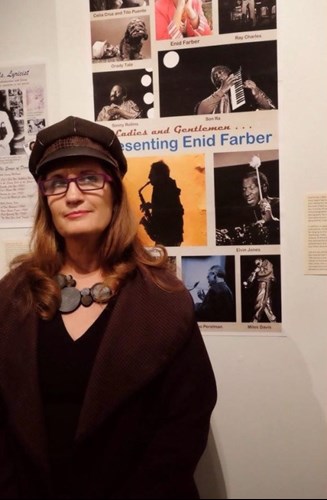
Enid Farber © Courtesy Akasha, Inc.
Thomas Chapin was not so much a "colleague" as a frequent subject of my lens, a favorite and preferred one at that. Thomas was rare in the milieu of jazz men whom I pointed my cameras at, in that he afforded me the greatest respect and never ever showed displeasure, attitude or sexist shun towards me. In fact, he demonstrated gratitude and acceptance and understanding that my role in contributing to the lexicon of jazz history was as valid as any member of his band. Each time I photographed him he accomplished something that was precious and all too rare for me, that being his spirit was so welcoming, his heart so full of love and respect for the audience and I felt the same generosity and acceptance towards me. Not all in his world of music have extended the same kindness towards me and I am always going to remember that with profound gratitude.
My memory of his playing is mostly the joyousness that I felt emanating from the stage and Thomas' horn. His relative obscurity at that time was eclipsed by the magnanimity of his personality!
Enid Farber
Enid Farber is considered one of the world's top jazz photographers. Farber and her work were featured in Jazztimes Magazine's December 1997 "Classic Jazz Photography" issue as one of the masters of jazz photography. She was the sole female of four names mentioned in the New York Times in May 1997 as "one of the young generation of talented photographers documenting the current jazz scene". Some of Farber's classic jazz images were selected for noted filmmaker Ken Burns' historic 20-hour documentary on jazz aired on PBS in January 2001 and its companion book. In the 20th anniversary issue of Jazziz Magazine, the editors said, "If we were to identify a JAZZIZ visual historian, her name would no doubt be Enid Farber. For longer than a decade, her photography has taken readers on an odyssey, to experience the most adventurous music & to meet the most interesting personalities, from both the new and traditional worlds of jazz".
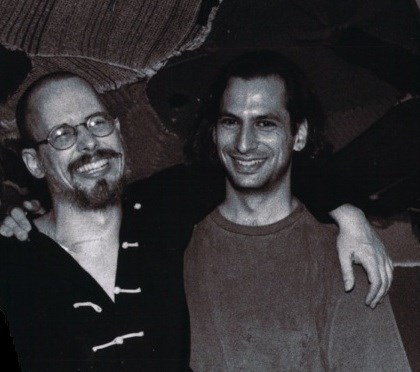
Thomas and Sam Kaufman © Enid Farber
(Photo permission by Akasha, Inc.)
It was a privilege to know and work with Thomas Chapin who left such an important and lasting musical legacy. Thomas had a unique view of the world that allowed him to see and hear things that other people could not. His insights and observations came out, not just through his music, but through everything he did in life. Just being in the same room or space with Thomas had a way of opening you up to new possibilities. I’ll never forget seeing Thomas when I was in Amsterdam and at the North Sea Jazz Festival. The festival had so many bands playing simultaneously but Thomas’s sound cut through everything and drew me right in. Never satisfied to remain on stage, he would stroll among the audience with his wireless mic and find individual connections with audience members. For anyone new to Thomas’s music, I would highly recommend listening to the opening track on Anima. Thomas had an energy and spirit that lives on today and belongs to the canon of great jazz -- and music in general.
Sam Kaufman
Sam Kaufman was Thomas Chapin’s friend and agent/manager during the last year of his life. He now runs a partnership marketing agency where he works as an agent for brands such as Bloomingdale’s, Hugo Boss and Canon.
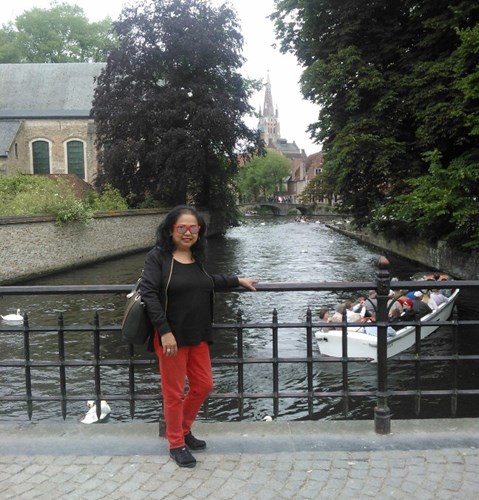
Teresita Castillo © Jos Demol
from Terri Castillo Chapin, NYC:
It's gratifying to see the force of Thomas Chapin and the power of his music still inspires and continues to generate high interest and relevancy among new listeners, musicians, including younger, next-generation players, and the general public since his passing in 1998.
For those of us who knew him, who played with him and who saw him perform live, it is no surprise, as Thomas was an original, "the real deal" as international saxophonist John Zorn has said. Thomas himself explained it: "Music was never something I had to consider, it is my state of being."
Now, the new documentary, "Thomas Chapin, Night Bird Song" by Emmy-winning filmmaker Stephanie J. Castillo, captures and celebrates his deep spirit as a human being and as one of the great players in jazz who left us too soon at age 40. When Thomas passed 18 years ago, critics told me, "Thomas will only get more known as the years pass. He will always be discovered by new audiences because people are always looking for quality, and that is what Thomas was about."
This has proven to be true. He is Alive--in the music, in our hearts. And in new hearts.
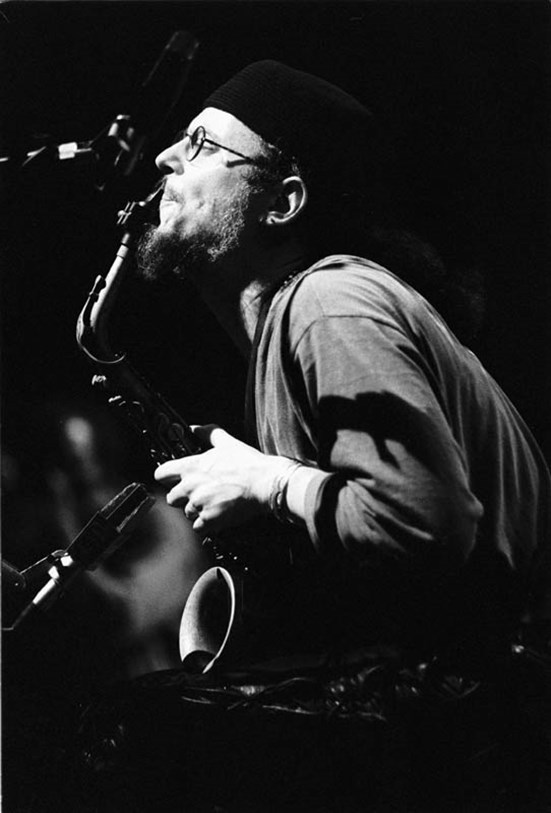
Photo permission by Akasha, Inc.
Chapin pushed his saxophones and flute to the bursting point, squeezing out colors and manic, joyous figures in a high-energy performance with his trio Friday night at Hartford’s 880 Club. Under his fleet fingertips, he has the whole free jazz reed tradition of Ornette Coleman, John Coltrane, Eric Dolphy and Albert Ayler. But the tumultuous free jazz spirit of the 1960s is merely a launching pad for his ascensions.
Owen McNally, Hartford Courant, 1994
Like one of his main musical inspirations, Rahsaan Roland Kirk, Chapin approached live performances with an extroverted sense of theater. Also, like Kirk, Chapin’s mastery of his instruments, particularly alto saxophone and flutes, were provocative on their own terms. He was a monstrous saxophonist, and certainly one of this generation’s flute masters.
Larry Blumenfeld, JAZZIZ, 1998
Chapin… is a virtuoso… also one of the more schooled musicians in jazz, both technically and historically, and for his set he dug into the styles of everyone from Benny Carter to the 60’s avant-gardists, screeching and howling and huffing as if this were 1964 and he was breaking the rules of jazz into pieces.
Peter Watrous, The New York Times, 1995
Chapin was a study in the testing and exceeding of limits. In every live set and on every recording, he plunged headlong into the musical abyss and responded with a driven yet upbeat concept that held humor, cataclysm and contemplation in rare equilibrium. The sound tapestries that resulted – solidly rooted in a tradition Chapin knew intimately, yet straining that tradition’s boundaries at every turn – were both lucid and combustible. They remain just as inspiring now that Chapin is gone. ‘The point is to stay awake and alive to what is going on,’ he wrote in 1996; and the sounds Chapin left assure that he continues to be a living force."
Bob Blumenthal, Boston Globe, 1999
Multi-instrumentalist Thomas Chapin was one of my guiding lights when I started getting into jazz really heavily in the 1990's. His Knitting Factory releases are all stellar, and he could play anything from swing to bop to free, but was possibly at his best when combining all genres or dispensing with the notion of genre entirely.
Tom Hull, blog "Music and More," 2011
Whooooah! To keep up with saxophonist/flautist Thomas Chapin on this one, you’re going to need some of those monkey adrenal glands Hunter S. Thompson wrote about, or at the very least a seat belt and a note from your mom. Ride--and if ever an album deserved an exclamation mark at the end of its title, this is one--is a 72-minute recording of a 1995 North Sea Jazz Festival performance of near-constant, broiling and searing emotional heat. It’s magnificent, monumental and practically unprecedented. Chapin, who died tragically young in 1998, was his own man, but his music resonated loudly with the work of reed giants from an earlier age. Earl Bostic, Rahsaan Roland Kirk and Eric Dolphy are the influences most commonly cited in this regard. Like their music, Chapin’s is drenched in the blues, and his use of vocalization (particularly on the flute) can be traced directly back to Delta penny whistle musicians recorded by musicologist Alan Lomax in the ’30s and ’40s.
Chris May, allaboutjazz review of RIDE CD, 2007
The first time I heard [Thomas Chapin] play was in 1988 on an LP entitled, The Sex Queen of the Berlin Turnpike, a jazz-and-poetry mix written and produced by a central Connecticut friend, poet-bass player Vernon Frazer. Chapin provided musical accompaniment to Frazer's readings here and, in years to come, at such NYC venues as the Nuyorican Café and the Knitting Factory.
As I listened, I became acutely aware of this flute coiling around Vern’s incantations and bass lines in lucid, deceptively simple patterns. As I grew up a flautist manqué, however reluctantly, I paid attention when people did unexpected things with the instrument, especially in jazz. And whoever was playing had nailed down a lyrical, probing style that refused to lean heavily on the flute’s naturally pretty tone. (The tone wasn’t pretty. It was beautiful, rich and – was it possible? – evenly layered.) And then I heard the alto sax solos. They could burn like scalding water. But they also soared; sometimes like jets, other times like gliders. More than anything, it was the relentless invention, the let’s-try-anything ingenuity that knew how to swing, bop and blow the blues in the grandest manner, but could step “outside” conventional changes with a nonchalance that seemed highly evolved even for the greyest of beards.
I checked the name on the cover: Thomas Chapin. Hadn’t heard of him before that point and was chagrined at myself for not paying attention. I’d assumed he was this lesser-known veteran of the black music wars who likely spent the previous decade-and-a-half trolling through lofts along the eastern seaboard. “Who is this Thomas Chapin cat?” I wrote Vern, who in turn told me he was this barely-thirty-something white guy from Manchester, Connecticut.
Manchester? Really? I’d spent part of my early newspaper years writing about that east-of-the-river suburb and, whatever its myriad virtues and defects, the next-to-last thing I’d have expected was someone who could wail like this. When I played this record to another colleague from those long-ago Hartford Courant days, his head swiveled as sharply as mine had to the sound of Chapin’s alto. When I told him who was playing and where he was from, my friend shook his head. “Shit, man,” he said. “Nobody from Manchester ever blew like that!”
Gene Seymour, March 20, 2013
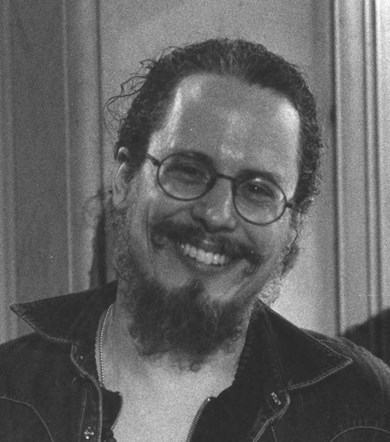
© photo courtesy of Akasha, Inc.
Thomas Chapin: Music as an Olympic Event
AUG. 8, 1996 by Mike Zwerin, International Herald Tribune
PERUGIA, Italy— Thomas Chapin describes himself as "flying under the radar."
He's never won a major poll, and he's not on "young lion" lists. At the age of 39, as today's definition goes, he's not even young. Encyclopedias do not yet mention him. Major promoters are only now beginning to solicit him. He is, however, an example of the depth of quality in the world of jazz — and of how quality can still prevail.
Audiences knew they were on to something good for 10 straight nights in the Club Il Pozzo during the Umbria Jazz Festival. (Giving such a deserving under-radar name such a break earns this festival points.) The audience was not numerous, but to quote Fats Waller, the joint was jumping. (The first set began at midnight.) You did not have to have perfect pitch to jump up and down and give the Thomas Chapin trio a standing ovation.
The trio — Chapin, Mario Pavone, bass; Michael Sarin, percussion — performs "mostly original compositions that mix rock-style ostinatos, hard bop, rhythm and blues and free jazz." Not "free" in the in-your-face sense, though that too, Chapin's post-Ornette Coleman alto saxophone is "out" while in. Inbounds out of bounds, if that makes sense. When in mainstream mode, he resembles his teacher Jackie McLean.
Some years ago, Chapin made a decision to make the kind of music worth living for. A tough balancing act between métier and spirituality, this is notably harder than merely making a living making music. A bandstand for him is like a stage for an actor.
People have an idea that a stage is where things are made up, while he figures it's more real than so-called real life. Super reality. It's an altar, a sacred place. He gets this beatific look on his face after a solo.
Music is his fate rather than a choice. He doesn't want to play, he must play. He plays therefore he is. This at least partially explains all the standing ovations in the Club Il Pozzo.
They were not a collection of fans; they were just normal people touched by the whimsical, unpompous generosity. He and his fellow musicians make each other laugh. A constant humorous patter, a certain impishness, is always evident. They have been together for seven years and so the jokes can be inside.
Critics have commented that they are too frivolous, that music should be taken more seriously. But Chapin considers frivolity a serious matter. The band will hit a series of accents, out of time, without signals. A sort of game, trying to throw each other off. It's funny. They've been together so long and are by now so together that they cannot make a mistake no matter how hard they try.
After studying at the Hartt College of Music in Connecticut, and Rutgers University in New Jersey, Chapin moved to New York where Lionel Hampton hired him to play lead alto and be his musical director. Bizarre, Chapin had never thought of himself as any sort of a director. He held the job for six years. Then he followed Eric Dolphy, Charles Lloyd and Arnie Lawrence in the prestigious reed chair of Chico Hamilton's esteemed quintet before forming his own trio.
He soon realized that the trio's textures and structures were so delicate that the full attention of the entire audience was required to make them work. As Yogi Berra might have put it: "You're not really listening unless you're really listening." (Chapin takes full responsibility for communication; if you don't get it it's his fault not yours.)
But they were playing in bars, audiences made bar noise. He finally decided that John Cage had resolved the problem years ago — bar noise was just a sort of Cagian attention. Anyway, lighten up, man. It's better than a day gig.
This interview was turning into a colloquy. Questions like "who is your biggest influence?" (Rahsaan Roland Kirk) and "when is your next record coming out?" ("Haywire," the Thomas Chapin Trio plus strings, will be released in September on Knitting Factory Records) seemed inappropriate.
But it's tough to deal with stuff like this without getting corny or boring. Where does he draw the line between ego and self-awareness? His ego can divert his attention, he'll be thinking about Thomas Chapin playing, one step removed. There are different selves involved, you learn to lean on one or the other of them. Music is a way to discover these selves.
"Playing music," he says, "is like a workshop on the subject of life. It's a microcosm of the way everything works. It instructs us about the principles of the workings of the world. All music is food, It just depends on how you digest it."
He lives a "streamlined life" in Jackson Heights, Queens, a proletarian outpost in New York City. He tries to keep his financial and emotional overheads to a minimum — a minimum of encumbrances. He has no children, for example. He's a "very careful" person. He calls himself a "conservative." He does not jump up and make important decisions easily. Odd for somebody whose profession is the taking of risks in public. He spends "a lot of time in angst."
You have to have a serene fall-back point. It's a matter of will — do the essential thing no matter what. Although this is more than "the show must go on" sort of thing, you must, for instance, perform at a top level even if you're sick and tired of performing. Meditation helps him develop serenity. Success helps too — the standing ovations made him realize that his "forward looking" music had reached the point where it was appealing to a more extensive and varied audience than he had imagined.
He came out of his 10-night "marathon" in the Club Il Pozzo knowing that he's no longer interested in mere chit-chat. Let's really say something. Hit the ground running. No warm-up, forget pacing. Do not leave anything on the plate. Say it all. Give everything you've got. The moment is now. Playing music is like an Olympic event.
The Thomas Chapin Story, a documentary film
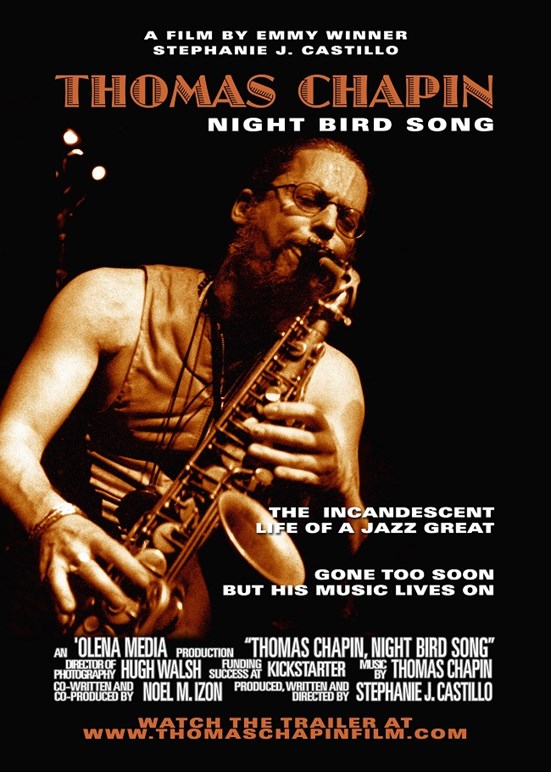 Movie Poster Photo by Alex Lopez
Movie Poster Photo by Alex Lopez
Through the documentary NIGHT BIRD SONG: THE THOMAS CHAPIN STORY, you will discover a never-been-told story straight out of the jazz history books about the short but remarkable life of Thomas Chapin, a creative musical force who emerged in the 1980's in New York jazz scene, whose highly original style helped move the music forward in the 1990's.
Chapin was admired for his exuberance as a multi-instrumentalist, band leader and composer. Once a musical director for the legendary Lionel Hampton, he was one of the few artists of his generation to exist in both the worlds of the New York City's downtown, experimentalist scene and the uptown scene of mainstream jazz. The saxophonist-flautist was just making his mark when his life was cut short when died from leukemia in 1998 at age 40.
You will meet a passionate soul who lived like there was no tomorrow in tireless pursuit of doing what he loved. In the face of a childhood condition that left him aware every day that life was fragile, Thomas Chapin soared and gained altitude, living out his dream of making edgy, engaging, exhilarating music that pushed jazz forward.
Though he passed 15 years ago, his music lives on. And through the film, an unforgettable tale of love and passion, courage and boldness will unfold. NIGHT BIRD SONG is a tragic yet triumphant story of one artist who took the road less traveled, who faced its end much too soon when dreams still burned.
Before he passed, Thomas Chapin had come into his own: having realized his own signature sound, having released numerous important albums, having gained a reputation for many outstanding live performances, and he was on the cusp of wide-audience recognition when he died. Thomas Chapin continues to be highly regarded as an influential and inspirational force to those who knew him and to those who continue to discover him.
At his death, Chapin was called a virtuoso, "full of incredible energy, experimenting and pushing the envelope all of the time, never letting up."
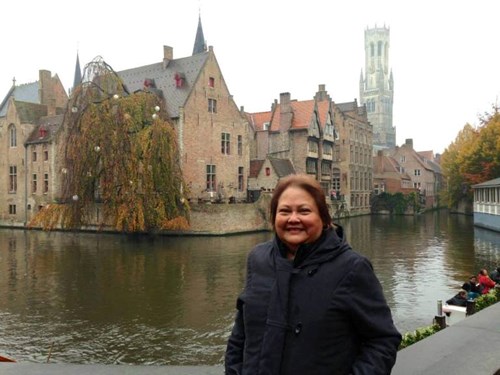
Stephanie J. Castillo © Jos Demol
EMMY Award-winning documentary filmmaker Stephanie J. Castillo's NIGHT BIRD SONG: THE THOMAS CHAPIN STORY will now reveal to the world this important voice for jazz missed in the 21st century, a voice that will continue to exhilarate and inform the music for generations to come. This is Castillo's 10th documentary.
More information about the film and the 2-DVD set of the film at http://www.thomaschapinfilm.com/
Milestone Film Showings:
Nice, France, Int'l Film Festival, May 2016
Monterey (California) Jazz Festival, September, 2016
Jazz at Lincoln Center, NYC, March, 2017
Awards:
"Best Story" Prize, Nice, France International Film Festival, May, 2016
"Posthumous Documentary" Prize, New York Jazz Film Festival (Harlem), November, 2016
"Best Music Documentary" Prize, Asbury Park Music and Film Festival (New Jersey), 2017
People who saw the film said, in this order:
'All jazz students/musicians should see this film.'
'All creative arts students/artists should see the film.'
'All human beings should see this film.'
(a 27 year old music programmer in NYC who cried because the film touched him so and 'changed
his life' and how to live it)
'EVERYONE SHOULD SEE THIS FILM!"
(a 70-year-old man, who never knew or met Thomas and was a first-time viewer of the film, in UK)
Quotes from viewers who saw the film in NYC:
And, wow, thank you so much for inviting us to see this wonderful film.
I think I responded...with a somewhat perfectly unplanned pause saying that the film changed me. Sometimes you pause and stumble a little when you want to put into words how something made you feel that you don't feel often. I believe that to be true here. Sadly, we don't all leap into the yes and live our lives to the fullest. Or, often times we live our work-life to the fullest and forget about our actual life. Thomas seemed to be able to do both at the same time. When he played those instruments simultaneously on stage that seemed to say exactly that, "I'm all in"..."with all of it!" And, I loved it. I think this message whether consciously noticed or not doesn't matter, the viewer will feel it, which is exactly what jazz does, and his music certainly made you feel it. And, to show us this in the way Stephanie did was amazing. And, that certainly is not as easy as she made it look. You truly feel as if you just met someone great who you wish you could spend time with so he could rub off on you and inspire you. With this film, we all get to have that opportunity and that is something to be grateful for.
I ... wanted to share something with you to extend my gratitude.
Derrick DeMay, 3/21/16
There are a lot I can say, but I want to be brief. I am still under the influence of the film. I am not a fan of jazz music, and I almost feel anxious with the avant-garde jazz music. But I don't think that we meet beautiful souls like Thomas very often in our lives. For me, his personality, his energy and beautiful smile came even before his music. And the beauty of his music owes a lot to his personality. Maybe this is the first time in my life, I enjoyed this kind of music (no boundaries, moving back and forth between melodies, harmonies and improvisations). And Stephanie does an incredible thing with the narrative of the documentary. She and Thomas have no mercy, the audience falls in love with his music after a while, it is more than enjoying the music now. It comes with Thomas' personal story, yet music always has much more than our imaginations... Who would say that a Kurdish man from Turkey will come and see your music at NYC and fall in love with Thomas and his music? Ara told me how open minded and imaginative he was, I have no doubt that his imagination and music will travel the world with this film. I already started telling him to my friends at Princeton and Turkey (through Skype). Thank you again.
all my best,
Onur Gunay, 4/15/16
Dear Terri:
Thank you for letting me share a piece of what it was to know this beautiful person... It's truly breath taking. Even now I cannot hold back the tears... The are so few things that are worth sharing but love and beauty must away remain our gift to each other. Stephanie and her team made Thomas live forever, I sure not just in my heart but everyone who has experienced this film. What a spirit. What a gift. The power of his sound spoke to me before I even knew his story. That smile, I see why you fell in love with him. I have never shared in the beauty of a persons last breath but as Thomas played his final performance I felt his spirit and it spoke to every part of my life and to everything I hope to achieve in this short time we share with each other. I appreciate the honesty and passion Stephanie has put into this work. The film, Thomas, his music, art, love he had for people, and his adventurous spirit lend to my belief that we are meant to change each other. For this I am truly thankful. He would have been a person I would have called friend.
Your friend,
T. Deyond Patrick, 3/10/17
Reviewed for Jazz Podium (April 2017 issue) by Hans-Bernd Kittlaus (in German with English translation):
Thomas Chapin
Night Bird Song
Film zu beziehen unter : http://www.thomaschapinfilm.com/
Thomas Chapin war ein Phänomen. Ein blasser schmächtiger weißer Junge, der Jazz spielen wollte wie sein Vorbild Rahsaan Roland Kirk. Und das tat er dann – mit einer unter die Haut gehenden Intensität, einem unbändigen Willen zu spielen und einem eigenständigen Sound vor allem auf Altsaxofon und Flöte. Angesichts dieser überquellenden Lebensfreude und Neugier hatte es eine besondere Tragik, dass er 1998 mit gerade 40 Jahren an Leukämie starb. Seitdem halten seine Hinterbliebenen, insbesondere seine Ehefrau Terri Castillo Chapin, die er nach langer Beziehung heiratete, als er schon erkrankt war, das Andenken an Thomas Chapin aufrecht mit bemerkenswerten CD-Veröffentlichungen (Alive, Knitting Factory (8 CDs); Never Let Me Go, Playscape (3 CDs)). Jetzt haben Terri Chapin und ihre Schwester Stephanie J. Castillo als Filmemacherin die monumentale Film-Dokumentation “Night Bird Song“ veröffentlicht, die das Leben Chapins konsequent aus einer liebevollen Innensicht heraus nachzeichnet. Die zahlreichen Videos, die sie in den Film integriert haben, zeigen die gewaltige Intensität seiner Live-Auftritte, aber auch viele berührende private Momente, etwa von der Hochzeit. Die Bild- und Tonqualität ist naturgemäß nicht immer perfekt, aber akzeptabel. Chapin war tief verwurzelt in der Jazz-Tradition. Er spielte von 1981 bis 1986 in der Big Band Lionel Hamptons als Altsaxofonist und Musical Director. Nach Überwindung seines Alkoholproblems begann er dann, sich einen eigenen Namen zu machen, vor allem in der Zusammenarbeit mit Bassist Mario Pavone. Seine Musik wurde immer wagemutiger. Wie bei Roland Kirk verschmolzen auch bei Thomas Chapin Tradition und Avantgarde. Die Aufnahmen lassen den Zuschauer Chapin’s Fähigkeit erleben, das Publikum emotional zu berühren und eine Verbindung herzustellen. Als er am Ende auf dem Sterbebett lag, war sein einziger verbliebener Wunsch, noch einmal zu spielen. So schleppte er sich zu einem Benefiz-Konzert, das für ihn an seinem Wohnort veranstaltet wurde, und spielte ein achtminütiges Flötensolo von einer Reinheit und inneren Ruhe, die selbst in der Filmwiedergabe außerweltlich anmutet. Wenige Tage später war er tot. Diese wunderbare Dokumentation wurde auf zahlreichen Filmfestivals gezeigt und mit Preisen ausgezeichnet. Es gibt sie in einer 150 Minuten-Langversion und einer 90-Minuten-Kurzversion, jetzt auch auf DVD.
Hans-Bernd Kittlaus 27.02.17
English translation:
Thomas Chapin
Night Bird Song
See more about Film and how to buy it: http://www.thomaschapinfilm.com/
Thomas Chapin was a phenomenon. A pale thin white boy who wanted to play jazz like his idol Rahsaan Roland Kirk. And he did – with an intensity that got under the listener’s skin, an irrepressable will to play, and an individual sound, in particular on alto and flute. Given this overboarding joie de vie and never-ceasing curiousness it was a great tragedy that he died from leukemia at 40 in 1998. Since then his family, in particular his wife Terri Castillo Chapin who he married after a long relationship when he was already ill, have kept the memory of Thomas Chapin alive with remarkable CD releases (Alive, Knitting Factory (8 CDs); Never Let Me Go, Playscape (3 CDs)). Now Terri Chapin and her sister Stephanie J. Castillo as film maker have published the monumental documentary “Night Bird Song“ which celebrates Chapin’s life from a loving inside perspective. The numerous videos they have integrated in the film show the overwhelming intensity of the live concerts, and also many moving private situations, like the wedding. The quality of video and sound is not always perfect, but good enough. Chapin was deeply rooted in the jazz tradition. From 1981 to 1986 he played in Lionel Hampton‘s Big Band as alto saxofonist and musical director. After leaving an alcohol problem behind him, he started to establish himself as a band leader, in particular in cooperation with bass player Mario Pavone. His music became more and more daring. Similar to Roland Kirk, tradition and avantgarde merged seamlessly in Thomas Chapin’s playing. The film let’s the viewer experience Chapin’s ability to connect and touch his audience on an emotional level. At the end when he was close to death his only remaining wish was to play one more time. He forced himself to a benefit concert organized for him in his home town and played an 8-minute flute solo which even in the film seems otherworldly in its purity and inner peace. A few days later he died. This wonderful documentation has been shown on a number of film festivals and received several awards. It is available in a long version of 150 minutes and a short version of 90 minutes, now also on DVD.
Hans-Bernd Kittlaus 27.02.17
GET THE DVD NOW! GO TO http://www.thomaschapinfilm.com
AN ESOTERIC REVIEW OF THE FILM
These thoughts flowed out of film viewer Kevin Moccia who had never met Thomas, but saw the film premiere in NYC, 2016, and immediately wrote down these thoughts that came to him.
CHAPIN'S TIME
by Kevin Moccia
There is a vibration, a sound, when one hears it, they know where it comes from, the reason why so many people remember hearing Thomas Chapin play, is because they were brought to that place inside themselves where God resides, an oasis where the universe hands out buckets of water filled with color and sound.
An artist is first true to his craft, then to himself, and all the while true to his or her creator. At some point in Chapin's life, he leaves the confines of what is safe, puts an outboard motor on his flute and sax, grabs his friends, and heads to find himself in his own voice, the voice that he was sent to find, that voice that will and has lead others to the "universal well".
Without the Knitting Factory, this particular artist would have only jumped, not bounced on the trampoline, which was the surface the Knitting Factory supported him with, the surface that allowed his leaps to linger higher, and his sound to have a further reach, and to find those that needed to hear it. Without Chapin's sound, particular artists are lost, because his sound is their way to themselves.
This film should be distributed to every conservatory student and to every college where musicians go first "to play", because in it, is the basic tenements, of how to teach and nurture a musician, so that he can survive beyond the campus walls.
And yes, show it in its entirety. Because the voice of one man or woman, can only reach those that can hear him or her, whereas the voice of another will not. If not for Thomas being mentored by artists who lived "the life, he would never have gone the extra year to Rutgers, where he would meet the man that would open up the GATES into Lionel Hampton’s fold. You can hear Hampton's influence in the foundation of all of Chapin's later works.
One and done, might not have been enough. An artists' life is his full span, we were not cut short by Chapin's existence, he ran the true gamut of his time, it is us who are cut short, by not living the fullness of our own existence. If we cry for his loss, it is the loss of ourselves, and what we left on the table in our own days, when we weren't as inspired as such a being as Thomas Chapin. To hear his music is to hear ones own potential, riffing to the heavens, where the reciprocal process is ongoing, experienced, in living minds and hearts, as essential as a station, to give one rest--as essential as an iceberg is for a polar bear.
In one thousand years, young artists will be so inspired as artists are today, and more importantly, not musicians, but every man and woman that seeks to know their place in "this" thing we call existing. The universal sound that Chapin finds is that sound that an artist seeks when he is seeking him or herself, outside of time.
Without Thomas Chapin, who mastered the art of a single note, there would have been a vacancy at the head of the trail, and no musical breadcrumbs to lead others out of the woods.
The creators' wind, whistles through us all, some reeds are wet in "our" time and some take lifetimes to find such wetness, Chapin's sound, is moist and peels from the love of his being. Mourn not for his time being only 40 years, there is many lifetimes in his playing, he just burned through the being he was inhabiting because he wore it out. The filament could not sustain the amperage, but the light within the sound, will surge for centuries to come, and others, inspired by "Chapin's time" will be the lantern bearers for others yet to come.
From a collection made during the year of his illness in 1997
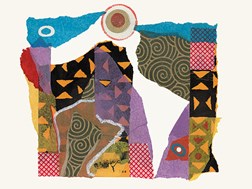
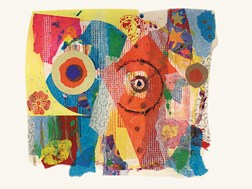
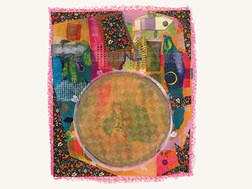
These are examples of Thomas's art collages on boards, usually 17" x 17", made with wrapping, decorative and found paper items, cut outs from magazines or newspapers, and marks of paint, chalk, pen, ink and rubber stamps. He did his collage art most of his adult life, along with pencil, colored pencil, crayon, and pen and ink doodles (like 'scribbles') in his journals and sketch pads. He also liked to work with rubber stamps and hand lettering which he used for many of his performance flyers, business cards, and his early tape cassette covers.
He was most prolific and created many of his visual art during his Trio music period in the late 80s and 90s, where he had a drawing table at a window in a quiet back room -- his music room -- where he lived with Terri in a second-floor apartment in Queens, New York. It was full of light and solitude and peace. It was also where he did his music composing, an electric piano and his instruments sprawled about. (Or where he might just sit and think and contemplate life while puffing a fat Cuban cigar!)
Thomas said, "I like collaging where you can put any image with any other image and it doesn't have to go together. I compose like that. I like to work spontaneously -- let chance come in as an element. I like to not think in the usual way, but to do 'without thinking.'"
Much of his art is stored along with his papers in the Music Collection at the Jazz Archives at Duke University (North Carolina). Many collages were also given to his family members and friends
Terri Castillo Chapin
School Crossing by Terri Castillo
film soundtrack by Thomas Chapin, 1987 (5'10")
Thomas Chapin, Music Man by Terri Castillo (1989) - PART ONE (6'16")
Thomas Chapin, Music Man by Terri Castillo (1989) - PART TWO (5'45")
Thomas Chapin, Dancing Chicken by Terri Castillo (1991) - PART ONE (5'30")
Thomas Chapin, Dancing Chicken by Terri Castillo (1991) - PART TWO (6'45")
Thomas Chapin Trio in Hawaii by Stephanie Castillo, 1993 (7'30")
Zasis Improvisatory Ensemble (Thomas Chapin, Rob Kaplan, Bill Sloat, Thad Wheeler),
April 5, 1980 @ Elizabeth Streb Studio, Canal St in NYC - PART ONE (5'18")
Zasis Improvisatory Ensemble (Thomas Chapin, Rob Kaplan, Bill Sloat, Thad Wheeler),
April 5, 1980 @ Elizabeth Streb Studio, Canal St in NYC - PART TWO (5'44")
Zasis Improvisatory Ensemble Reunion (Thomas Chapin, Rob Kaplan, Bill Sloat, with Geoffrey Gordon),
Sept. 20, 1992 @ the Knitting Factory PART ONE (7'16")
Zasis Improvisatory Ensemble Reunion (Thomas Chapin, Rob Kaplan, Bill Sloat, with Geoffrey Gordon),
Sept. 20, 1992 @ the Knitting Factory PART TWO (10'52")
Thank you Daniel Michel and Jazz at Toulon festival for this short clip:
Thomas Chapin Trio with pianist Armen Donelian, 1991 (2'11")
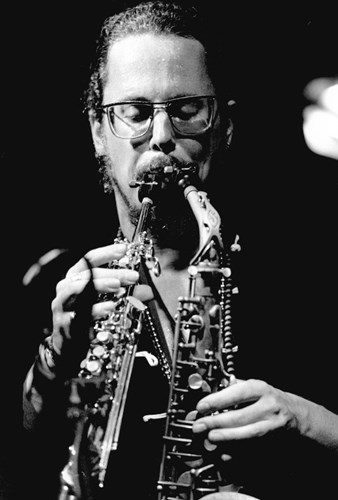
Photo permission by Akasha, Inc.
THOMAS CHAPIN TIMELINE
Education:
1975: Phillips Academy (Andover, MA)
1978: Hartt College of Music (CT)
1980: BA Music: Rutgers University (New Jersey)
Studies: Jackie McLean, Paul Jeffrey, Kenny Baron, Ted Dunbar
Experience:
1997: Thomas Chapin Trio Plus Brass
- JVC Jazz Festival (NYC)
- Litchfield Jazz Festival (CT)
1997: Thomas Chapin & Borah Bergman (duo)
- Du Maurier Downtown Jazz Festival (Canada)
1996: Thomas Chapin Trio
- JVC Jazz Festival (NYC)
- Umbria Jazz Festival (Italy)
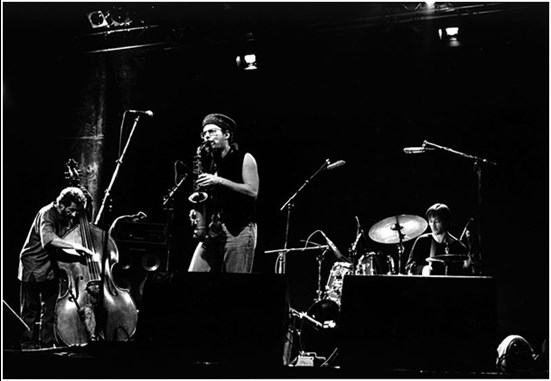
Photo permission by Akasha, Inc.
1995: Thomas Chapin Trio
- Newport Jazz Festival (Newport, RI) [Cable program aired nationally 1995-96]
- What Is Jazz Festival (Knitting Factory, NYC)
- Jazz a Vienne (France)
- North Sea Jazz Festival (Holland)
- Molde Jazz Festival (Norway)
- Pori Jazz Festival (Finland)
- Tondela Arts Festival (Portugal)
- Knitting Factory Tour of Europe
1994: Thomas Chapin Trio
- JVC Jazz Festival (NYC)
- North Sea Jazz Festival (Holland)
- Glasgow Jazz Festival (Scotland)
- Tampere Jazz Festival (Finland)
- Tallinn Jazz Festival (Estonia)
- SJU Concert Jazz Festival (Utrecht, Holland)
- Knitting Factory Tour of Europe
1994: Thomas Chapin Quartet
w/ Peter Madsen (piano), Reggie Nichoson (drums), Kiyoto Fujiwara (bass) closes the famous Village Gate jazz club on Thompson & Bleecker St. NYC, 2/94
1993: Thomas Chapin Trio
- DuMaurier Jazz Festival (Vancouver)
- North Sea Jazz Festival (Holland)
- Vittoria Jazz Festival (Spain)
- Frankfurt Festival (Germany)
- Newport Jazz Festival in Madarao (Japan)
- Honolulu Academy of the Arts (Hawaii)
- What Is Jazz Festival (Knitting Factory, NYC)
1992: Thomas Chapin Trio
- North Sea Jazz Festival (Holland)
- Ottawa Jazz Festival (Canada)
- Wolf Trap Jazz Festival (U.S.)
- Knitting Factory Festival Tour of the U.S.
- What is Jazz Festival (Knitting Factory, NYC)
1991 : Thomas Chapin Trio
- Toulon Jazz Festival (France)
- JVC Jazz Festival (NYC)
- Knitting Factory Tour of Europe
- What is Jazz Festival (Knitting Factory, NYC)
1990: Thomas Chapin Trio
- JVC Jazz Festival at The Knitting Factory (NYC)
- JVC/Newport Jazz Festival at Saratoga Springs (NY)
- Real Art Ways Jazz Festival (CT)
1988 – 1991: performances with:
- Clarence “Gatemouth” Brown
- Walter Thompson Big Band
- Borah Bergman
- Bob Moses
1988 – 1989: Chico Hamilton Quartet
- Tour of Europe
- Charlotte Jazz Festival (U.S.)
1988 – 1989: Thomas Chapin Spirits Rebellious (Brazilian music)
1987 – 1988: performances with:
- Alborada Latina w/Thad and Francesca Wheeler
- Carlota Santana Flamenco Dance Company w/: singer-dancer La Conja and guitarist Pedro Cortes
- Flamenco Latino w/Aurora and Basilio Georges
1987: Thomas Chapin Sextet
- JVC Jazz Festival at Saratoga Springs (NY)
1983: Thomas Chapin Sextet
- Greenwich Village Jazz Festival ’83
- The Blue Note, w/ Junior Mance Duo
1981 – 1986: Lionel Hampton Orchestra (as musical director/lead saxophonist-flautist)
- Tours of Europe, Japan, Mexico, South America and U.S.
- Festivals, including Kool Jazz (USA)
- Newport Jazz Festival (RI)
- Nice Jazz Festival (France)
- North Sea Jazz Festival (The Hague, Holland)
- Aurex Jazz Festival (Japan), etc.
Television/radio broadcasts and recordings:
Prior to 1980
- Lionel Hampton All Stars (New Orleans)
- Paul Jeffrey Big Band (NYC)
- Livingston College Jazz Ensemble (lead alto) (NJ)
- Zasis Improvisatory Ensemble (NYC and New England)
- Spiral (New Music Group using Baschet Brothers Sound Sculptures) (also featuring Steve Swallow on bass)
- Jazz Clarion (Hartford Conservatory)
- Talking Drums (Latin Jazz)
- Tour of Europe (1978) w/Dalton School Jazz Ensemble (NYC)
- Tour of Russia (1975) w/Massachusetts Youth Wind Ensemble (New England Conservatory, Boston)
- Protean Theatre (Hartford, CT)
- Bassett Watts Hough Prize (for excellence in woodwind playing)
- Phillips Academy (Andover, MA)
Media:
2016: "NIGHT BIRD SONG: Thomas Chapin" by Stephanie Castillo
documentary film by filmmaker Stephanie J. Castillo (color, 90 mins.)
"Best Story" Prize, Nice, France International Film Festival, May, 2016
"Posthumous Documentary" Prize, New York Jazz Film Festival (Harlem), November, 2016
Shown at Monterey (CA) Jazz Festival, September, 2016
1993: “JAZZ MAN: Thomas Chapin in Hawaii” by Stephanie Castillo
Hawaii Public Television - Short documentary portrait produced & directed by Stephanie Castillo, (color, 7 mins.)
Trio performance footage from Honolulu Academy of Arts; Thomas and friends improvize a fun "concert"
with soda bottles atop the windy Pali cliffs
1991: “DANCING CHICKEN MAN: Thomas Chapin” by Terri Castillo
Short, documentary videotape. Produced and directed by Terri Castillo (color, 11 mins.)
Fanciful, but serious, discoveries by Thomas Chapin about dance and movement, improvisation
and performance; a visit to dancing chicken in NY's Chinatown: "sometimes I feel like a 'dancing chicken.'"
1989: “MUSIC MAN: Thomas Chapin” by Terri Castillo
Short, documentary film. Produced, directed and edited by Terri Castillo (color, 12 mins.)
TVC Award, 12th Annual New School for Social Research Film Fest 1989
Portrait of Thomas Chapin as music maker and his relationship to sound and ordinary objects,
also in relation to art collage.
1987: "SCHOOL CROSSING" by Terri Castillo
Short film-montage set to music. Produced, directed and edited by Terri Castillo. (color, 5 mins.)
Sound track: music, voice, instrumentation by Thomas Chapin
Kin-O-Lux Achievement Award, 10th Annual New School for Social Research Film Fest 1987
About a Queens, NY neighborhood's morning awakening around school kids and a crossing guard.
(This was where Thomas lived in the 80s and 90s with Terri.)
Grants:
1992: Recipient of performance grant from NEA for Trio concerts at Kampo Cultural Center, NYC
1991: Recipient of music grant from NEA for study of Afro-Carribean percussion with Louis Bauzo
1988: Recipient of music grant from NEA for composing and recording (Spirits Rebellious album)
Published:
1985: “10 Compositions” book of original compositions by Thomas Chapin. Copyright © Peace Park Publishing-BMI.
_____________________________________________________
EDITOR'S NOTE: AKASHA, INC., a 501(c)(3) non-profit corporation, is helping to preserve Thomas Chapin's Music Legacy and keep his indomitable spirit alive for generations to come. Together with some dedicated musicians, professionals, family and friends, we are working to collect historical and biographical items; collect, preserve and publish raw recordings, audio and visual works; and bring his music and compositions into academic environs. Akasha has placed Thomas’ archives within the Special Collections at Duke University (North Carolina), created the Thomas Chapin website, released posthumous CD releases: Ride (2006) and Never Let Me Go (2012), with new releases yet forthcoming, has produced music-tribute concerts in the memory of Thomas Chapin, and supports the film, Night Bird Song (2016) by filmmaker Stephanie J. Castillo. Tax-deductible contributions can be made to support Akasha's work to help keep the legacy of Thomas Chapin going. Donate via the Paypal donation page at www.thomaschapin.com or contact us by email at akasha.chapin@gmail.com about how to send a check or money order, U.S. dollars only, made out to "Akasha Inc." Foreign checks/money orders, please add $25 U.S. for bank fees & handling. Thank you for supporting Thomas Chapin, his legacy and his music to continue for future generations.
We invite you, the reader who had some connection to Thomas -- whether a personal one or through his music alone, -- to write about it and send it to us: info@jazzhalo.be. Then we will publish it here as "From the Readers". Thank you!
Unfortunately I didn't have a personal connection with Thomas Chapin. I just missed meeting him in 1998; he had passed earlier that year. But I did see the film about Thomas, 'Night Bird Song,' in March, 2016, and can speak to 'meeting' him through the film:
This was one of the very few films I've seen in my life that I would consider truly transformative. It starts off as a pretty innocuous music documentary, but about an hour in - when Chapin pours his life force into a saxophone solo, plaintively hitting high notes, searching for meaning, making a bid for the stars - tears of recognition started trickling down, and I knew it was turning into much more. Sure enough, as I followed Chapin throughout his mercuric rise within both the uptown and downtown jazz scenes, his search for meaning and authenticity, his swearing off alcohol in order to "unstuff his horn," his increasingly electrifying performances as he found inner consistency, culminating in a triumphant show at Newport Jazz Festival '95, and an unforgettable flute solo 12 days before his untimely demise at 40 from leukemia - I found myself shaken to the core, tears streaming down, taking stock of my own life. This was self-evaluation of the most valuable sort - derived from a positive, inspiring role model who demonstrated the possibilities of life, the value of being human, and the beauty around and within us. Those 150 minutes may well have changed the course of my life, and only for the better."
I would add about the film: Required viewing for all jazz musicians. Indispensable viewing for all other musicians, and really all human beings.
Andy Wanning
New York, New York, USA
The last time I saw Thomas Chapin perform was in the early nineteen-nineties when he was touring with the Knitting Factory. It was the first time I heard his trio. I attended their performance at a San Francisco club by myself, and then I was very sorry I hadn’t invited someone else to go with me to have this experience. Thomas was fully engulfed in his performance, as if he and his saxophone were one. The band was on fire, and the music was a weaving of old and new and not-yet-born. It was traditional, non-traditional, be-bop, and everything else imaginable. I remember thinking in absolute wonder that if someone from another planet was trying to understand the word “jazz,” I would bring them here. This was jazz. It was all there that evening and it was the best.
Lonnie Hull DuPont
Jackson, Michigan, USA
I saw Thomas Chapin live at festivals two times in the 1990’s, at the East-West Festival in Nuernberg, Germany, and at the North Sea Jazz Festival at The Hague, Netherlands. What I remember most are his exuberant creativity, his palpable will to play and connect, and his emotional intensity. He gave so much, and the audiences responded. I am really glad that the wonderful documentary Night Bird Song is now available to everybody on DVD.
Hans-Bernd Kittlaus
Rheinbreitbach, Germany
I grew up a block from Thomas, in Manchester, CT. From the age of 6-8 years old, Tommy (as we called him then) and I were besties. He moved away, and we mostly lost touch, though I went to see him a few times and was awed by his transcendent talent. My question: Is the film available on DVD or streaming for purchase? I never got to see it, and would very much like to. Thank you for celebrating his remarkable life and music.
Jonathan Adams
Manchester, CT, USA
Editor's Note: Hello Jonathan! Read all about the 2-DVD set of the film and various ways on how you can get a copy if you go to www.thomaschapinfilm.com. Then, write back and tell us how you like it!
I was 13 years old and obsessed with music when Thomas Chapin passed, but I'd never heard his name. The next year, I was desperately seeking out some of the unsung heroes of jazz, and coincidental e-mail recommendations from both Ned Rothenberg and Gerry Hemingway led me to seek out his albums, which were very hard to get in Utah. I was instantly hooked. To this day, I would say his music has meant as much to me as that of any other single person. I'd go so far as to say that if I ever amount to anything as a musician, I will owe a certain amount of the credit to Chapin and his music. ...And if I didn't have a religion already, Alive [8-CD Trio boxed set] would probably be my bible.
About the film Night Bird Song
I've known Thomas Chapin for most of my life as a man who died young, like Clifford Brown or John Coltrane. That has tinged my perception of his music. This film makes me feel like I knew him a bit better when he was alive and vibrant. And I had heard of his very last performance, but I never expected to see it. It felt almost sacred, if that makes sense, as though it were so personal and significant to Thomas that I, a stranger, wouldn't deserve to see it. I was close to tears by the end.
Steve Peterson
Orem, Utah, USA
Why I cherish my memories of Thomas so much.
My mum always listened to classical music and I had some piano lessons, but never understood what it means to practice. So, to my regret now, I never really learned to play. Maybe also because I discovered Jazz only too late. I was 19 and at university in Munich, Germany, when I went to my first Jazz concert. A dear friend took me along ... a winter night in an industrial, remote area of Munich, taking the underground, then a bus, then walking through the snow, passing derelict industrial sites ... we entered a vast hall, almost empty, just some bistro tables and chairs in front of a stage with three musicians ... sax, cello and drums. We sat down, the band started to play ... I never had heard anything like this ... so strange, not really music to my ears at the time, but so painfully beautiful ... something touching me that was not from this world. I still remember the names of the cello and the sax player, Hank Roberts and Tim Berne. A magical night. Even though, next to us, there was only one other table of listeners, they played and played through the night ...
Ever since, it must have been in the late 1980s, I have been looking for a reprise, for another player, another band, creating such a magical moment. I went to all the concerts I could catch that featured players from New York and the Knitting Factory. I heard many great concerts, not least because the local Munich jazz club, the Unterfahrt, regularly had bands from New York visiting. But those magical moments I can count on one hand. And two of them I owe to Thomas Chapin. Once in Karlsruhe in Germany and another time when I visited New York for three weeks in 1995 and spent most nights at the Knitting Factory. Thomas's playing really was something else ....
Alexander Kurz
Orange, California, USA
about Thomas by Teresita Castillo
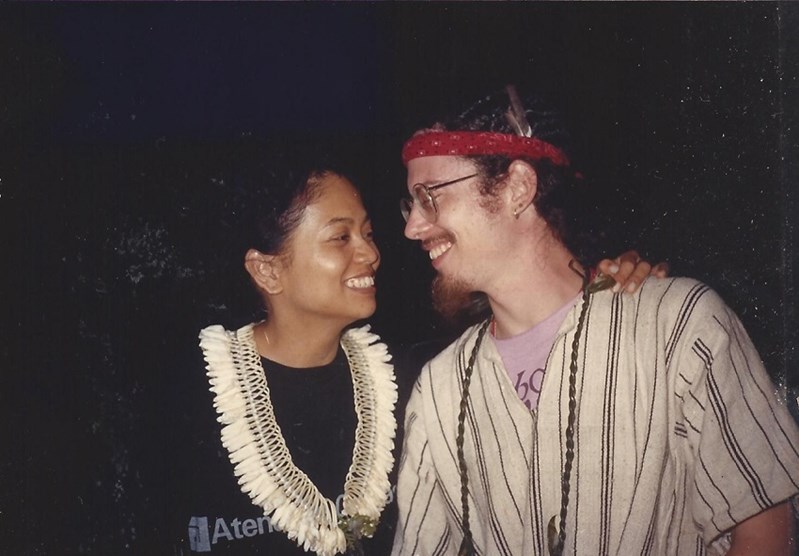
Terri and Thomas Hawai ca 1987 © Photo permission by Akasha, Inc.
The late saxophonist-flautist-composer jazz legend, Thomas Chapin, born in 1957 in Manchester, Connecticut, USA, left us too soon at age 40 in 1998. He left behind great recordings of his music, some 15 CD albums with his Trio and Quartet, as well as recordings with other legends, like Lionel Hampton, Sonny Sharrock, Ray Drummond and as sideman for multitude other greats.
His wife Terri Chapin Castillo has been keeping his legacy going since with new releases, a website, supporting young musicians who have discovered him and are now playing his music on tours and on CDs, and a new large ensemble work with woodwinds, never before heard, but composed in the last year of his life, is about to be recorded and performed for the first time live by musicians in Montreal.
Among other things Terri is keeping alive in his music, is also their love story, told in a visual sketchbook — how they met in NY’s Grand Central Station, dated, fell in love, and married and how he left too soon, but through his music and memories, he lives on. Here is Terri’s visual story sketchbook of their life together, titled 'Love Lives Forever’ "

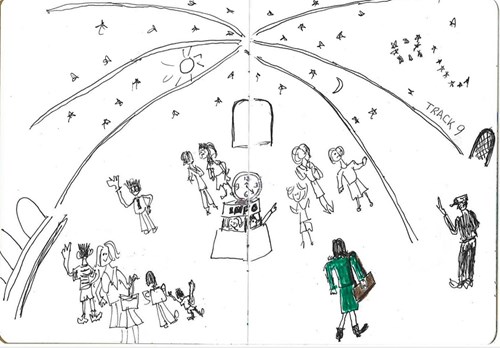
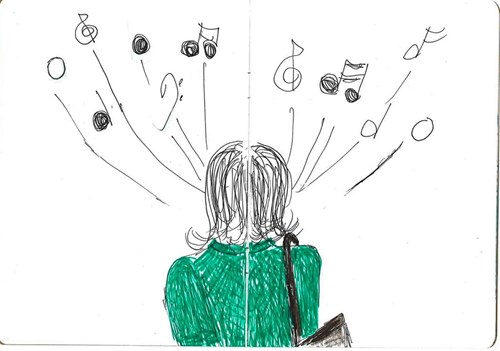
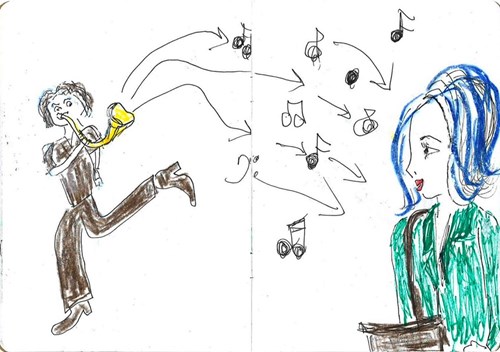
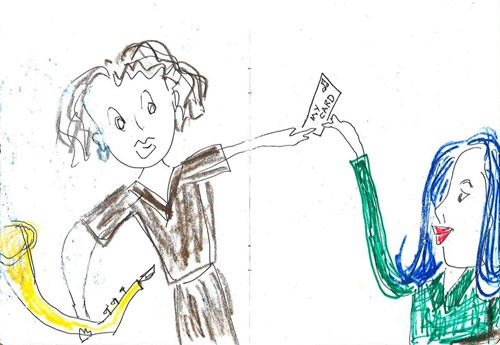
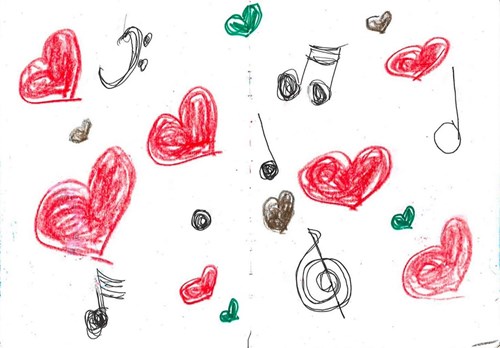

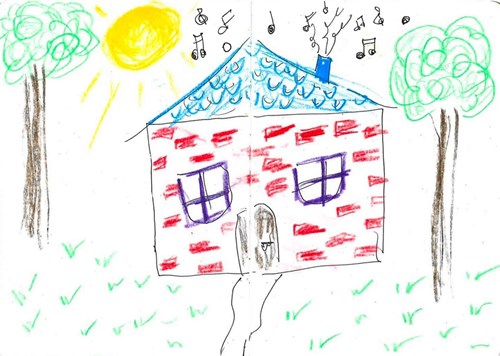
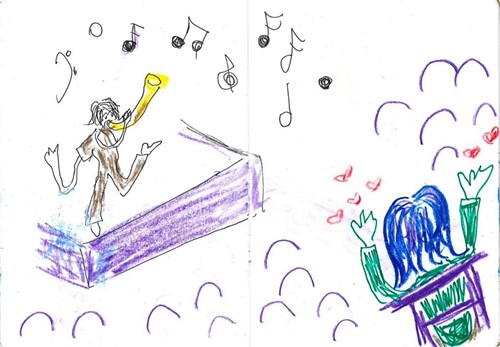

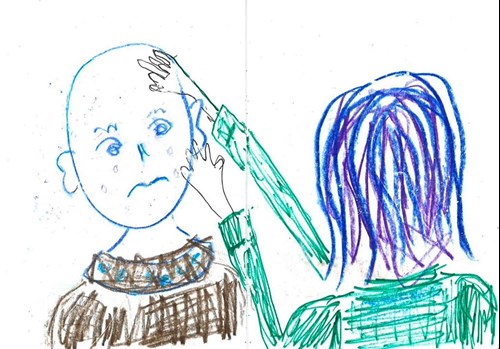
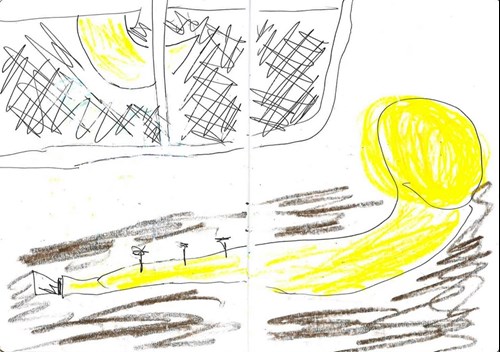
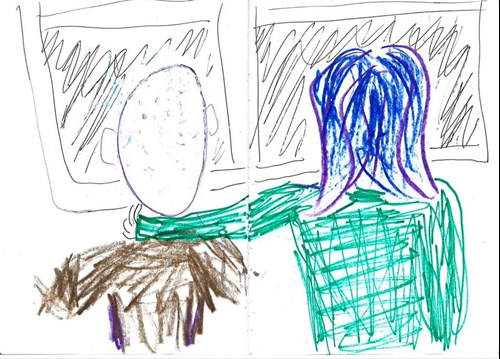
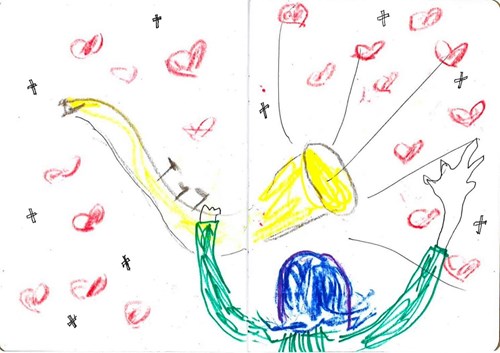
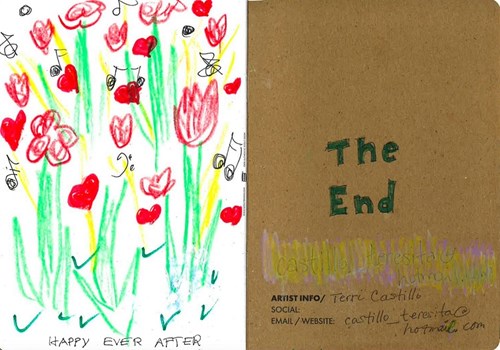
© Terri Chapin Castillo
July 15th, 1995 North Sea Jazz Festival Den Haag
© Geert Vandepoele

July 9th, 1994 North Sea Jazz Festival Den Haag
© Geert Vandepoele
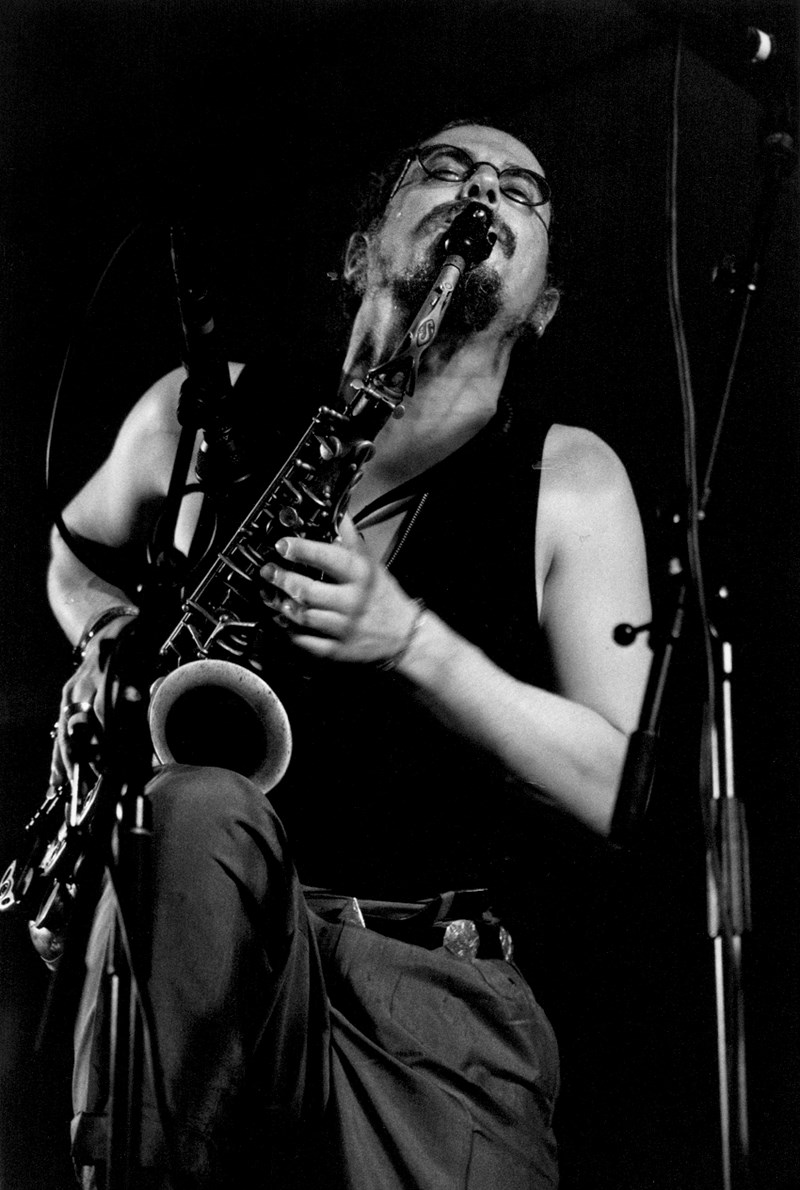
1988 - Thomas Chapin with Peter McEachern, Goshen, CT
Photos © Mark McEachern
Thomas is playing his mbira, a thumb piano.
Peter McEahern is the trombone player on the Chapin albums "Bell Of The Heart" and "Insomnia".

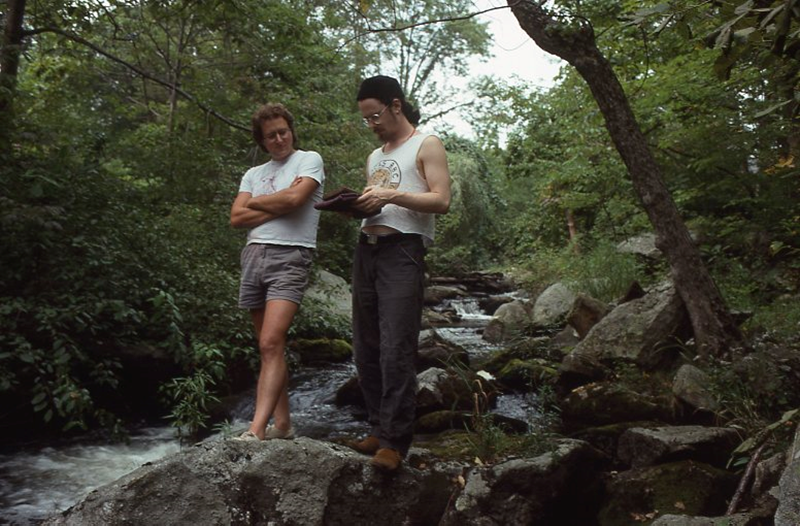





Peter McEachern, a Connecticut native, has toured and recorded three CD’s for Polygram with Blues legend Clarence “Gatemouth” Brown; has worked and recorded with minimalist composer Lamonte Young, and is featured on several important CD’s: Insomnia with the Thomas Chapin Trio on Knitting Factory Works and Song for Septet, with the Mario Pavone Septet on the New World Countercurrents label.
Song for Septet was chosen one of the “Top Ten Jazz CDs of 1995” by The New York Times. In addition, Peter recorded the Wendy Chambers piece, A Mass for Mass Trombones on the Centaur label. He received a fellowship for music composition from the Connecticut Commission on the Arts in 2001.
He is a member of The CT Composing Improvisers Project which includes Stephen Haynes, Mario Pavone, and 2010 Grammy winner David Darling. The group has an unreleased recording.
Currently he is the Chairman of the Music Department at Salisbury School, and is a busy freelance artist in the tri-state area. Peter has been a teaching artist at the Litchfield Jazz Camp since 1998. In 2015 he has released 2 CD’s No Chordtet featuring Dave Santoro, George Sovak and Hamir Atwal as well as Shockwave featuring the late Thomas Chapin, Steve Johns, Mario Pavone and Jamie Finegan.
© Litchfield Performing Arts
In case you LIKE us, please click here:
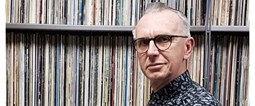
Foto © Leentje Arnouts
"WAGON JAZZ"
cycle d’interviews réalisées
par Georges Tonla Briquet

our partners:
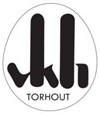


Hotel-Brasserie
Markt 2 - 8820 TORHOUT
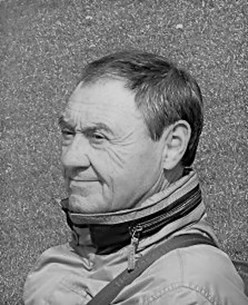
Silvère Mansis
(10.9.1944 - 22.4.2018)
foto © Dirck Brysse
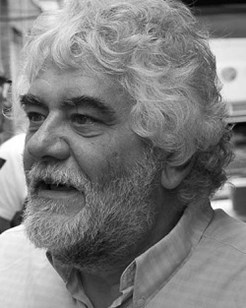
Rik Bevernage
(19.4.1954 - 6.3.2018)
foto © Stefe Jiroflée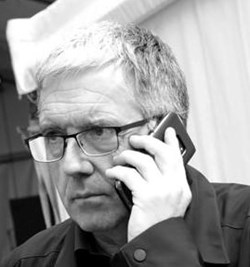
Philippe Schoonbrood
(24.5.1957-30.5.2020)
foto © Dominique Houcmant
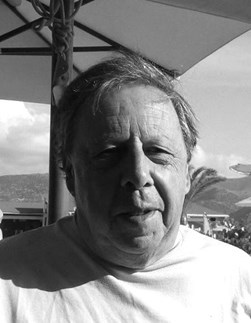
Claude Loxhay
(18/02/1947 – 02/11/2023)
foto © Marie Gilon
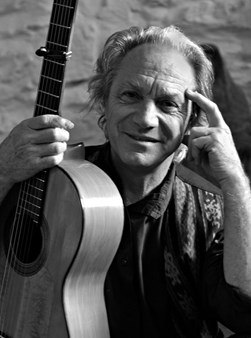
Pedro Soler
(08/06/1938 – 03/08/2024)
foto © Jacky Lepage
Special thanks to our photographers:
Petra Beckers
Ron Beenen
Annie Boedt
Klaas Boelen
Henning Bolte
Serge Braem
Cedric Craps
Luca A. d'Agostino
Christian Deblanc
Philippe De Cleen
Paul De Cloedt
Cindy De Kuyper
Koen Deleu
Ferdinand Dupuis-Panther
Anne Fishburn
Federico Garcia
Jeroen Goddemaer
Robert Hansenne
Serge Heimlich
Dominique Houcmant
Stefe Jiroflée
Herman Klaassen
Philippe Klein
Jos L. Knaepen
Tom Leentjes
Hugo Lefèvre
Jacky Lepage
Olivier Lestoquoit
Eric Malfait
Simas Martinonis
Nina Contini Melis
Anne Panther
France Paquay
Francesca Patella
Jean-Jacques Pussiau
Arnold Reyngoudt
Jean Schoubs
Willy Schuyten
Frank Tafuri
Jean-Pierre Tillaert
Tom Vanbesien
Jef Vandebroek
Geert Vandepoele
Guy Van de Poel
Cees van de Ven
Donata van de Ven
Harry van Kesteren
Geert Vanoverschelde
Roger Vantilt
Patrick Van Vlerken
Marie-Anne Ver Eecke
Karine Vergauwen
Frank Verlinden
Jan Vernieuwe
Anders Vranken
Didier Wagner
and to our writers:
Mischa Andriessen
Robin Arends
Marleen Arnouts
Werner Barth
José Bedeur
Henning Bolte
Erik Carrette
Danny De Bock
Denis Desassis
Pierre Dulieu
Ferdinand Dupuis-Panther
Federico Garcia
Paul Godderis
Stephen Godsall
Jean-Pierre Goffin
Claudy Jalet
Chris Joris
Bernard Lefèvre
Mathilde Löffler
Claude Loxhay
Ieva Pakalniškytė
Anne Panther
Etienne Payen
Jacques Prouvost
Renato Sclaunich
Yves « JB » Tassin
Herman te Loo
Eric Therer
Georges Tonla Briquet
Henri Vandenberghe
Peter Van De Vijvere
Iwein Van Malderen
Jan Van Stichel
Olivier Verhelst
